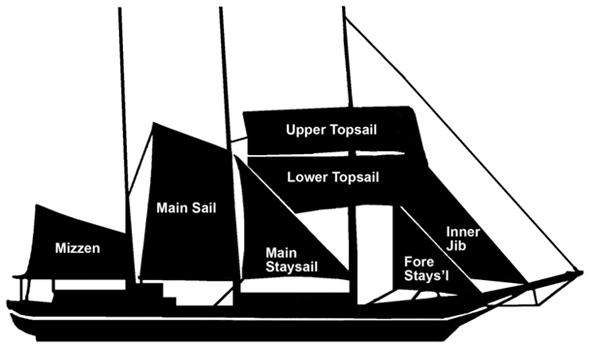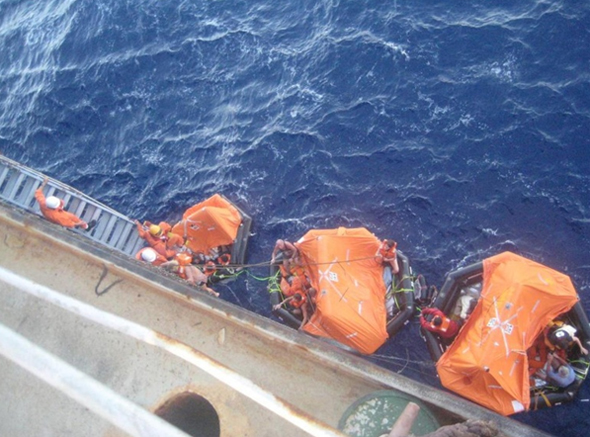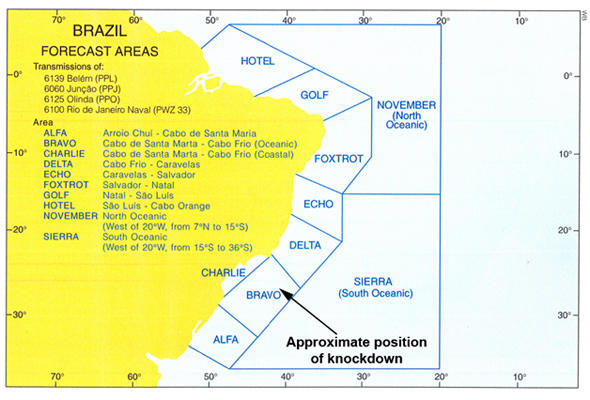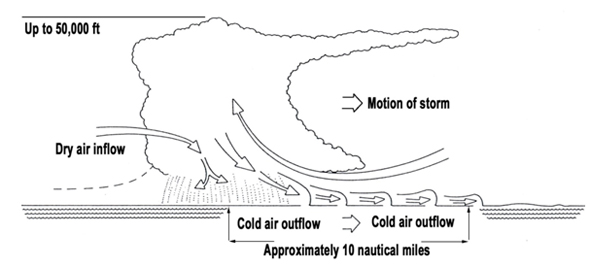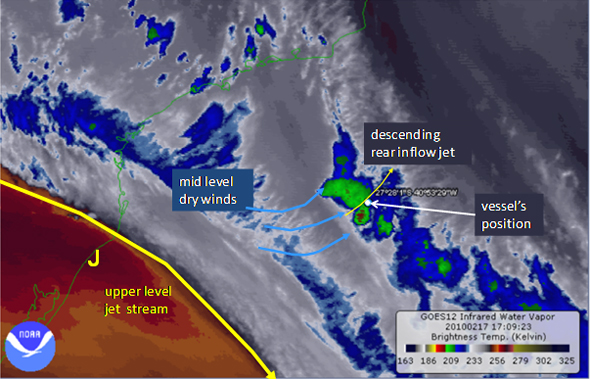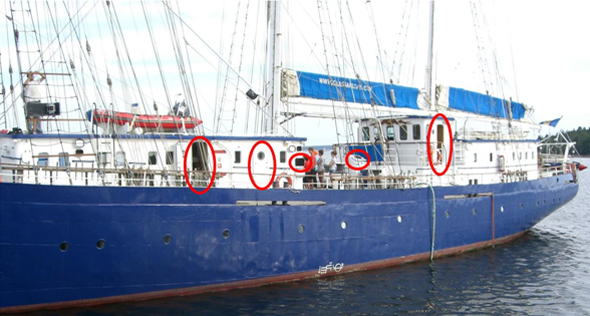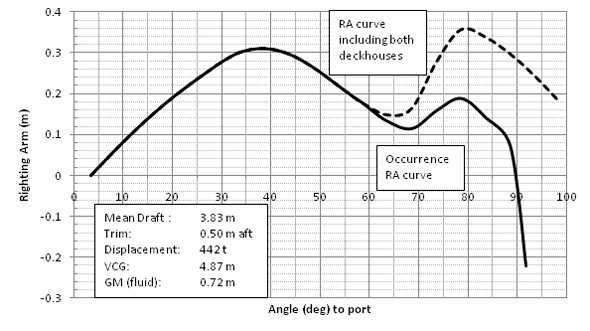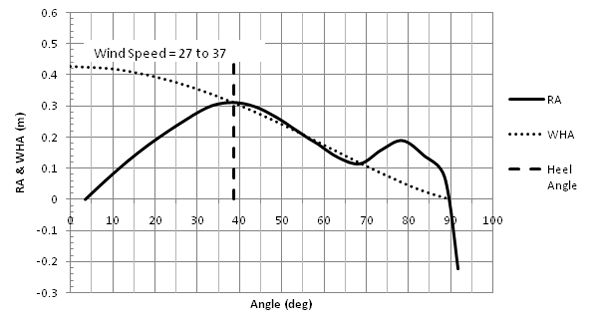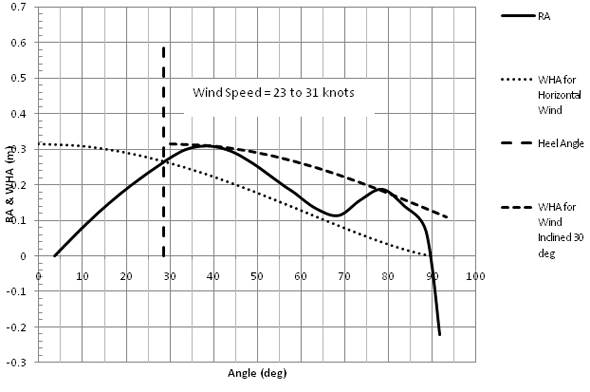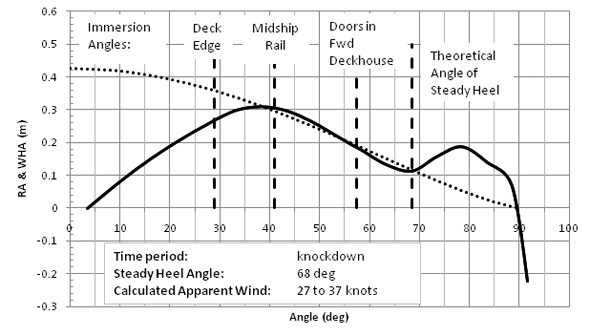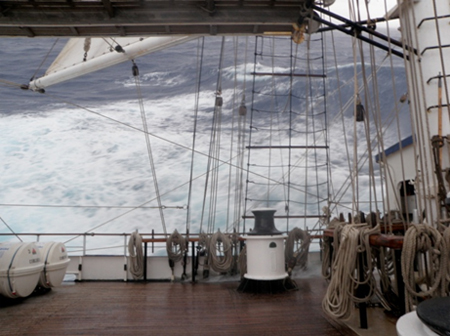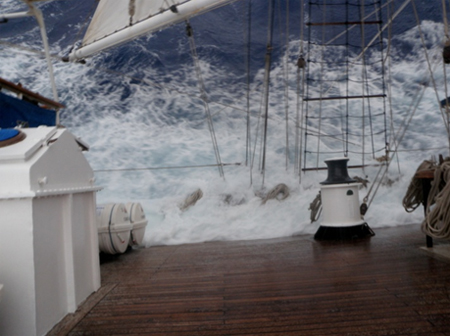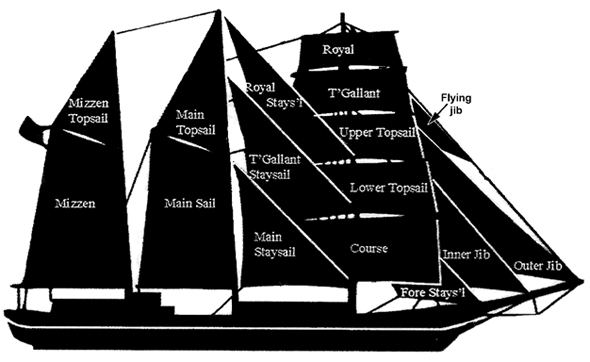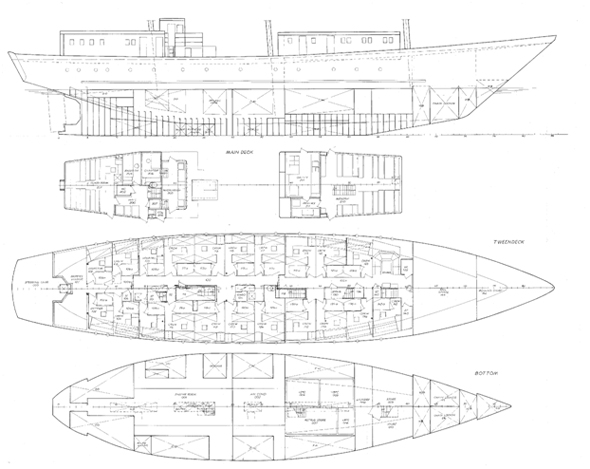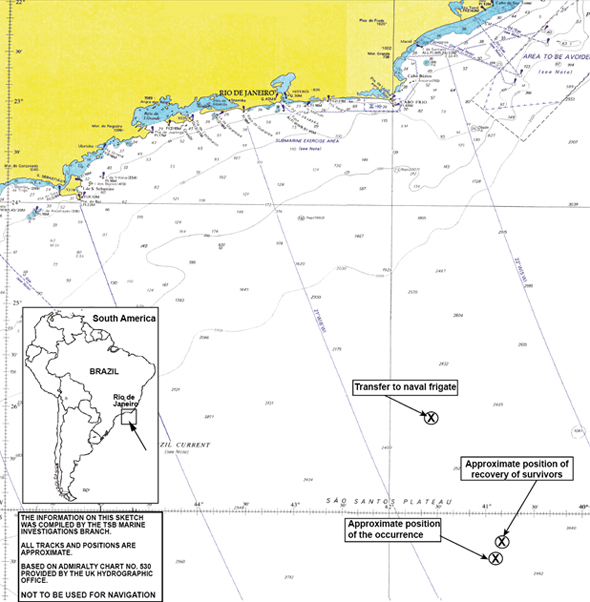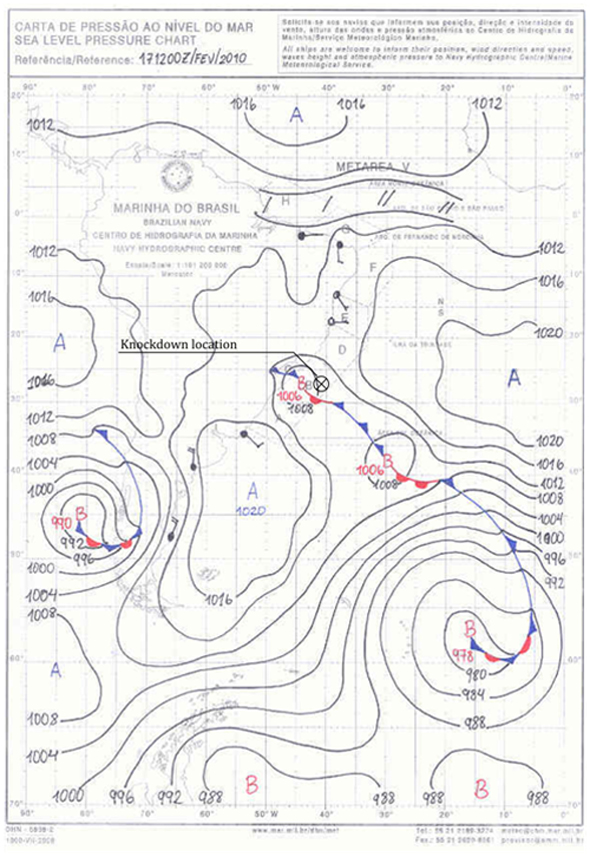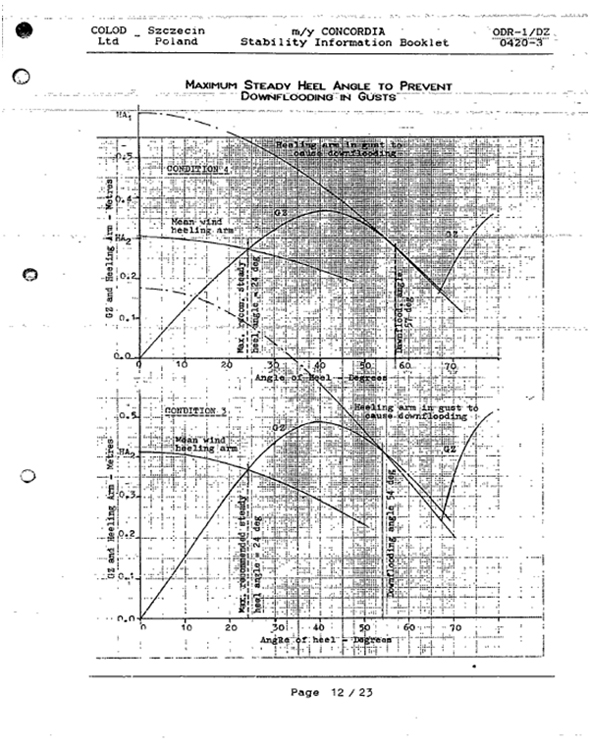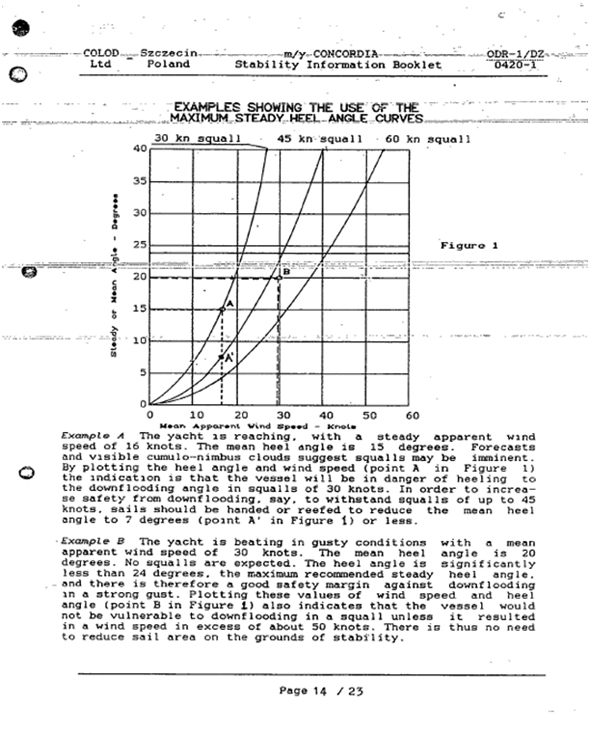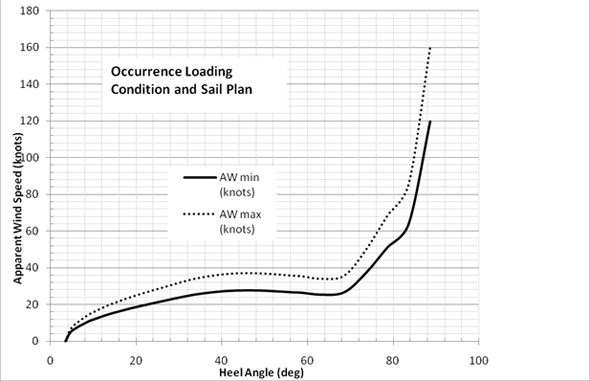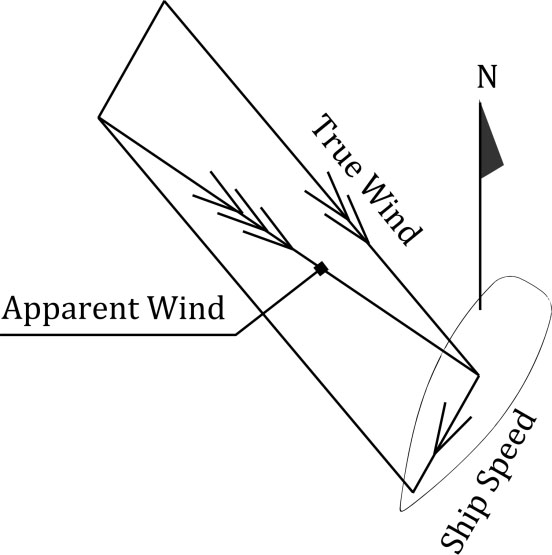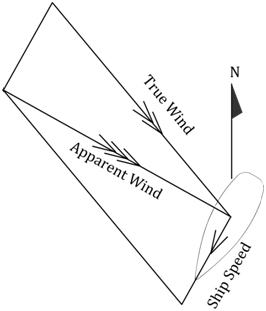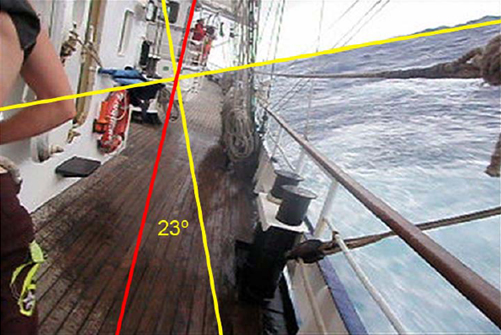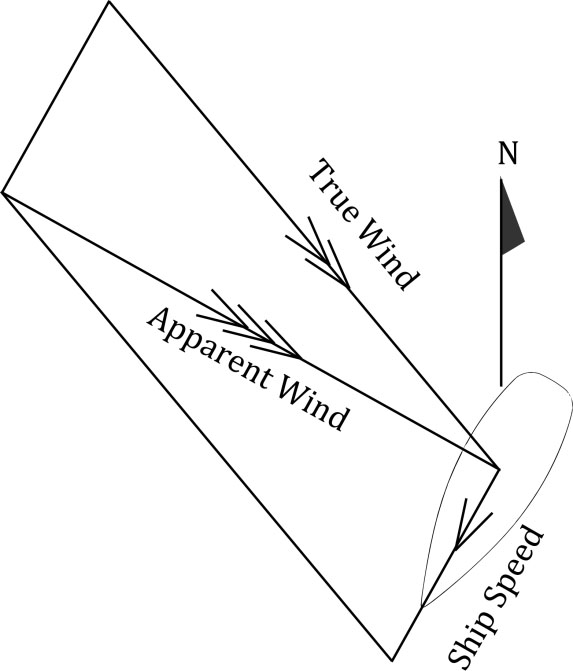Knockdown and capsizing
Sail training yacht Concordia
300 miles SSE off Rio de Janeiro, Brazil
The Transportation Safety Board of Canada (TSB) investigated this occurrence for the purpose of advancing transportation safety. It is not the function of the Board to assign fault or determine civil or criminal liability. This report is not created for use in the context of legal, disciplinary or other proceedings. See Ownership and use of content. Masculine pronouns and position titles may be used to signify all genders to comply with the Canadian Transportation Accident Investigation and Safety Board Act (S.C. 1989, c. 3).
Summary
On 17 February 2010, at approximately 1423, the sail training yacht Concordia was knocked down and capsized after encountering a squall off the coast of Brazil. All 64 crew, faculty, and students abandoned the vessel into liferafts. They were rescued 2 days later by 2 merchant vessels and taken to Rio de Janeiro, Brazil.
Le présent rapport est également disponible en français..
1.0 Factual Information
1.1 Particulars of the Vessel
| Name of vessel | Concordia |
|---|---|
| Official number | 1001269 |
| Port of registry | Bridgetown |
| Flag | Barbados |
| Type | Sail Training Yacht |
| Gross tonnage | 413 |
| Length (Length overall)Footnote 1 | 46.50 m (57.50 m) |
| Draught (Departure Recife, Brazil) | Forward: 3.8 m Aft: 4.0 m |
| Built | 1991, Colod Co. Ltd., Szczecin, Poland |
| Propulsion | Sail MAN 420 kW auxiliary propulsion |
| Complement | On board: 8 crew, 8 faculty members, and 48 students (64 total) |
| Registered owner | West Island College International, Inc., Bahamas |
1.2 Description of the vessel
The sail training yacht Concordia was built in Poland as a steel–hulled barquentine (see Photo 1). As such, the vessel was rigged with three masts: a square–rigged foremast, and fore–and–aft–rigged main and mizzen masts. The vessel could set four jibs forward and five square sails on the foremast. Between the main and foremast, the vessel could set three staysails; both the main and mizzen masts had gaff topsails and a main and mizzen sail, respectively. (Refer to Appendix A for sail plan.)
The vessel had three decksFootnote 2. The lowest deck comprised the engine room, fuel tanks, fresh water and ballast tanks, laundry facilities, and stores. The accommodation deck housed the cabins for crew, faculty and students,Footnote 3a captain's lounge aft and port side forward seminar room. Two watertight doors divided the accommodation deck into 3 separate spaces when closed. Access into and out of the 2 forward spaces was via a stairway, while access to the aft space was through a hatch in the deckhead.
Two deckhouses were on the main deck. The wheelhouse, chartroom, ship's office and classroom were located in the aft deckhouse, which was accessible from doors on the main deck, starboard and bridge deck, port and starboard. The forward deckhouse contained the galley, pantry, and mess, which was used as a second classroom. Both deckhouses had escape hatches along the centreline in the deck head. Entrance to the paint locker and bosun stores was via centerline hatches on the forward part of the main deck. The vessel's gangway was stowed overhead, supported on either end by brackets on the main mast and the wheelhouse.(Refer to Appendix B for general arrangement plan)
The vessel was equipped with 2 rigid hull inflatable boats (RHIB). The forward RHIB, which served as the vessel's rescue boat, was stowed on the mess deck and could be launched by means of a boom and electric winch. The other RHIB, used to transfer people to shore or for excursions, was located at the stern and stowed using davits. The wheelhouse contained navigation equipment and instruments including 2 radars, an autopilot, a gyrocompass, an electronic chart system, an anemometer and an inclinometer. The adjoining chartroom held the navigational charts as well as Global Maritime Distress and Safety System (GMDSS) radio communications equipment and a weather fax. This room was accessed directly from the wheelhouse by 3 stairs on the port side. The vessel could be steered using an autopilot or joystick from a center console in the wheelhouse, or from a hydraulic steering stand located in front of the wheelhouse on deck. This steering stand was equipped with a gyro repeater, a magnetic compass and an anemometer.
1.3 Description of Vessel Operations
The vessel was owned by West Island College International, Inc. (WIC Bahamas)Footnote 4 and time-chartered to West Island College International for Education and Sail Training LimitedFootnote 5 (WIC-NS). WIC Bahamas was responsible for vessel operations, including registration, surveys and hiring of crew. WIC-NS, known as Class Afloat, delivered academic programs to students aged 16 to 20 and was responsible for hiring faculty and delivering the curriculum.
The master and crew managed day-to-day operations, while WIC-NS was responsible for daily communication with the vessel and varying business needs of the voyage, including resupply and repairs management. For instance, when a repair was required, the issue would be identified and managed by the master/crew; the cost would then be authorized by WIC Bahamas and contracted out by WIC-NS.
The master, chief officer (C/O), and second officer (2/O) each stood a watch, while the bosun was assigned day work. The master stood the 8 to 12 watch, while the C/O and 2/O stood the 4 to 8 and the 12 to 4 watches, respectively. Students performed sail manoeuvres and watch duties, including lookout and helmsman responsibilities. Students could be assigned 1 of 6 different night watches, each lasting 2 hours. There were 8 students on each night watch. Day watches varied, depending on students' academic schedules. Generally, there were at least 6 students on each day watch. Part of each watch formed the navigational watch: 3 students reported to the bridge and functioned as helmsman or one of the lookouts, while the remaining students reported to the bosun for day work duties. Students not on watch were either in class or had time off. Faculty members were not assigned routine shipboard operations, although they were designated to carry out various emergency roles.
The vessel normally travelled from Lunenburg, Nova Scotia (N.S.), at the start of the academic year in September and returned near the end of the academic year after extensive foreign voyages in all types of weather. Given the academic aspects of the program, the vessel was generally sailed conservatively with a key consideration being the management of the heel angle and motions so that classroom activities could be carried out comfortably.
1.4 History of the Voyage
The vessel arrived in Recife, Brazil, on 19 January 2010. During the port stay, the students and faculty left the vessel as the first semester had concluded. At this time, the master and C/O were relieved. The 2/O, who had joined the vessel a few weeks earlier, remained on board. A week prior to departure, faculty and 48 students (16 of whom were new to the program) arrived on board. Some of the faculty were also new to the program. In the following days, all persons on board received training, which included familiarization and sail training. Several drills were also carried out.Footnote 6
The vessel departed Recife on 8 February 2010 at 1400Footnote 7 for Montevideo, Uruguay. As per usual practice, the master kept the Lunenburg office apprised of the vessel's daily progress by sending its midnight dispositionFootnote 8 the following morning. Several days into the voyage, the hydraulic steering stand developed a small leak. Crew were unable to rectify the problem; as a result, the outside steering position remained isolated with the wheel removed and lashed to the nearby railing. Steering was thereafter controlled via autopilot inside the wheelhouse.
Since leaving Recife, the vessel had encountered small squalls. By 16 February 2010, the vessel had received several weather forecasts through the Inmarsat C system, which were issued by the Brazilian Navy Marine Meteorological Service for the area.Footnote 9 These indicated that the wind would backFootnote 10 to the southeast/east and increase to Beaufort force 7 or 8Footnote 11 with gusts. The master informed the ship’s complement of the upcoming inclement weather.
On the morning of 17 February 2010, in anticipation of the expected weather, the master shortened sail, culminating in the following sail plan at the end of his watch (1200): inner jib, fore staysail, upper and lower topsails, main staysail, main, and reefed mizzen sails (see Figure 1).Footnote 12 The 2/O, whose watch was from 12 to 4, arrived in the wheelhouse at 1150. During the handover of the watch, the master and the 2/O discussed the sail plan and the 2/O was advised that it was suitable for winds up to 40 knots. The master instructed the 2/O to maintain, if possible, the wind abaft the beam and to keep a comfortable heel angle for the classes. He also instructed the 2/O to brace the yards and to trim the sails as required as the wind backed, and to bear off to port and run before any squalls. The 2/O and master then discussed action to be taken in case it was necessary to reduce sail. The vessel was on a broad reach,Footnote 13 on a starboard tack, with a course between 200° and 220° (G). The apparent wind speeds were between 15 to 18 knots, with seas of 1.5 to 2 meters from the north and a long, low southerly swell. The air temperature was between 29°C and 31°C.
At approximately 1300, the master went below to rest, leaving the 2/O in the wheelhouse and in charge of the watch. For the next 60 to 75 minutes, the vessel kept a course of 200° to 220° (G) travelling at approximately 5.5 knots. Conditions were Beaufort force 5 with apparent winds of up to 20 knots, just abaft of the beam. In these conditions, the vessel was sailing with a steady heel angle of about 10°.
Just before 1400, the new student deck watch arrived on the bow and reported to the bosun. Two of the 8 students relieved the lookouts on the port and starboard bridge wings. At about 1405, the main staysail was sheeted-in and the yards were braced one point to port.Footnote 14 Around this time, 3 squalls were observed broad on the starboard bow of the vessel and the 2/O began tracking them on the radar and visually.Footnote 15
Shortly afterward, it was determined that one of these squalls would intersect the course of the vessel. On the radar, this squall appeared rounder than other squalls encountered over the previous days. Visually, it seemed to contain more rain; however, there were no visible whitecaps.
At about 1410, with the squall 1.5 to 2 nautical miles away, the lookouts went below to collect their foul weather gear, while other students collected laundry drying on deck in advance of the rain. The windows and windward doors in both deckhouses were shut; the hatches to the bosun store and the paint locker were closed. The lee (port) doors in the galley, the wheelhouse and the mess remained open.
Shortly after 1420, the 2/O walked to the starboard bridge wing, observed the weather and noted the approaching squall. As it started to rain, he went back into the wheelhouse and closed the starboard side door. At around this time, the vessel’s port heel angle had increased to approximately 23°Footnote 16 and the apparent wind speed had increased to around 22 to 23 knots.
Once back inside the wheelhouse, the 2/O stood near the autopilot. The apparent wind speed started increasing, its angle started decreasing (shifting forward) and the vessel heeled further to port.
The 2/O pushed the port alter-course button on the autopilot 3 times in rapid succession. The wind continued to shift forward and the vessel continued to heel. The 2/O then activated the dial on the autopilot to alter course to port by 20° to 30° in order to obtain a larger course alteration. As the vessel continued to heel, he deactivated the autopilot and, using the manual control (joystick), put the helm over hard to port. While doing so, the port lookout entered the wheelhouse and the 2/O noticed the port bridge wing about to go under water.Footnote 17
The 2/O continued to hold the joystick until the rudder angle indicator showed hard over, at which point he took hold of the lookout, who yelled for assistance as she was in danger of falling overboard through a gap in the rail.Footnote 18 The 2/O then assisted her to the reception area behind the wheelhouse on the starboard side and then used the intercom to call the master. Water was entering through the port wheelhouse door,Footnote 19 and the anemometer showed an apparent wind speed of 30 knots from 120° to 150° on the starboard side. At approximately 1423, the vessel was on its beam ends following the knockdown.Footnote 20
1.4.1 Events in Wheelhouse Following the Knockdown
The master had noticed the increase in heel angle and was getting ready to go to the wheelhouse when the 2/O called him on the intercom. Following the knockdown, the master exited his cabin and proceeded to the reception area where, together with the C/O, he assisted students evacuating from the classroom. He also ordered the 2/O to close the port wheelhouse door. However, the 2/O was unable to do so as the door was under water. The master then ordered him to transmit a distress alert using Inmarsat C. However, the equipment could not be accessed because the chartroom had already flooded. The 2/O then retrieved the Search and Rescue Radar Transponder (SART) near the starboard wheelhouse door, and both he and the master exited the vessel. At this time, water was also observed entering via the window in the ship's office.
Once outside, it was noticed that the tops of the masts were in the water and that both the upper topsail and the reefed mizzen were torn.
Shortly before this, events were also transpiring elsewhere on the vessel, both above and below decks. These are described in the follow section.
1.4.2 Events Above and Below Decks
At 1400, prior to the knockdown, the vessel's complement was distributed as follows:
- The 2/O, the bosun and 8 students on day watch;
- 1 faculty member and 14 students in the classroom;
- 1 faculty member and 10 students in the mess;
- 1 faculty member and 2 students below deck in the seminar room, which was on the portside, forward on the accommodation deck;
- The remaining 6 crew members (including the master and C/O), 5 faculty members and 14 students who were not on watch or in class were, for the most part, in their cabins.
At approximately 1410, when the 2/O announced the upcoming rain, some students who were not in classes went out on deck to experience the rain. These students gathered in the waist of the vessel.Footnote 21 The vessel then began to heel—first immersing the deck edge and then quickly immersing the port side rail.Footnote 22 The vessel continued heeling rapidly and 1 student dropped into the sea, climbing back on board near the wheelhouse. Other students grabbed hold of deck equipment to steady themselves as the vessel came to rest on its port beam ends.
Immediately following the knockdown, the generator alarm sounded in the engine room, the generator shut off and the emergency lighting came on.
Students and faculty in the aft classroom climbed into the reception area, where they were assisted by the master, C/O and other students to climb onto the side of the aft deckhouse. The students and bosun in the mess were able to open the weather door on the starboard sideFootnote 23 and help one another onto the side of the mess. They then climbed through the rail and onto the vessel's hull, making their way aft to the other students, as ordered by the master.
With the vessel on its beam ends, those below deckFootnote 24 immediately started to evacuate to the main deck. Two faculty members, who had been assigned the duty of clearing cabins, exited their cabins and went directly to the main deck without first checking and clearing the others. The medical officer, who was also in his cabin, fell while trying to climb out, dislocating his left shoulder and breaking several ribs and his humerus. After reducing his shoulder,Footnote 25 he exited his cabin with the help of the C/O and they went on deck. A student who was unable to open her cabin door received help from a faculty member. As those from below deck made their way up to the mess, they were assisted by those already in the mess to exit the vessel. Once outside, they made their way along the exterior of the hull toward the aft deckhouse.
1.4.3 Abandonment
Once outside, students began retrieving immersion suits from a stowage locker below the wheelhouse on the main deck. The suits were passed to those at hand, who then donned them. Once on deck, the master ordered the officers to inflate the aft liferafts.Footnote 26 The engineers had started inflating the 20-person liferaft on the starboard side of the mizzen deck.Footnote 27 With the vessel on its beam ends, three 20-person rafts on the port side were underwater and inaccessible. The C/O inflated both the 8- and 10-person rafts, located on the stern of the main deck, and asked if the 2/O could see the Emergency Position Indicating Radio Beacon (EPIRB), which was stowed on the port side mizzen deck. The 2/O was unable to see the EPIRB, as the portside rail of the mizzen deck was submerged. The master ordered everyone on the aft deckhouse to board the liferafts; he then proceeded forward to the waist of the vessel, where he attempted to release the 20-person rafts on the starboard side. However, the Senhouse slip hooks could not be released due to the weight of the rafts and the angle at which they were hanging in their securing straps. The master then cut these straps, and both rafts fell into the water in the area between the main deck and the gangway.
On the mizzen deck, the 2/O climbed to the lifejacket locker box, which had opened, spilling some lifejackets into the sea. He passed the remaining lifejackets to the students on the starboard side of the aft deckhouse. As boarding the 20-person raft from this position was too difficult, it was moved to the vessel's aft end. After making their way there, students were assisted by the 2/O to board using the excursion boat, which had broken free from one of its falls, as a platform. This, however, was being tossed by the waves and was smashing into the davits, damaging the boat and the engine. The cook, meanwhile, collected the drinking water from the stowage locker below the bridge and moved the water to the various inflated rafts.
During the abandonment, the master accounted for the other 7 crew members. The students accounted for their watches. At this point, watch leaders shouted out when they had accounted for their watch, but this information was not confirmed until after the abandonment.
As the two 20-person rafts that the master had released in the waist of the vessel were too heavy to move, the master inflated one of them in its original place. However, it became trapped under the gangway. The master and bosun then attempted, unsuccessfully, to break the gangway free. The master inflated the other 20-person raft, but it too became trapped. He and the bosun then moved to the mess deck and cut the straps securing the rescue boat, which landed upside down and could not be righted. The bosun then cut the strap from the lifejacket locker box on the mess deck and the bosun and the master handed out the lifejackets to the crew and students on the starboard side of the hull.
The C/O instructed the students to pull the rafts that were at the waist of the vessel free. The master then cut them loose from entangled lines. The vessel at this time had rotated into the wind, so that the waves and wind battered the rafts against the vessel. The master, therefore, ordered that they be moved away from the hull, along the masts. The C/O returned to the bridge to retrieve the medical bag and a linethrower, which were passed to the rafts. On the stern, the 2/O continued to board students in the 10- and 20-person rafts. The 2/O had donned an immersion suit earlier, but had not completely sealed the neck. At one point, while assisting a student to board the raft, he was tossed from the excursion boat, was dragged down by gear from the vessel and had difficulty resurfacing when his suit filled with water.
The two 20-person rafts had been moved along the mizzen mast. Students and faculty boarded using ratlines and shrouds. Shortly afterward, the vessel rolled a further 20° to 30° and everyone was ordered to jump into a raft or the water. The master and C/O each took command of a 20-person raft. The 2/O helped the remaining students board the other 20-person raft, at the aft of the vessel, before boarding the 10-person raft himself. He cut the painter with his own knife, and passed it to the engineers who cut the painter of the 20-person raft. He then tied both painters together and passed the equipment bag from the 10-person raft to the 20-person raft—before finally transferring himself to the 20-person raft.Footnote 28
Meanwhile, the survivors in the other rafts struggled to get free of the vessel's rigging. Once freed, the two 20-person rafts were tied together and the bosun swam to join 3 students who were alone in the 8-person raft, which was still tied to the Concordia. Once there, he cut the painter, allowing the raft to drift free of the vessel. While recovering items from the water, a student noticed the EPIRB, which had self-released and activated. The bosun then swam out to retrieve it from the water. As some of the liferafts drifted around the stern of the overturned vessel, no damage to the hull was observed, and the rudder was hard to port.Footnote 29
A short while later, the master's 20-person raft was marshalled together with the C/O's 20-person raft and the bosun's 8-person raft.Footnote 30 The 20-person raft, containing the 2/O and the engineers, however, drifted away from them with the empty 10-person raft still attached.Footnote 31 At this point, it is estimated that 20 minutes had passed since the knockdown.
1.4.4 Events Following Abandonment
Once the master, C/O, and bosun marshalled their 3 rafts, the master took control of the EPIRB, tested its operation and switched it to manual. The master attempted to account for all members of the complement again by first identifying those who were not present. This generated a list of 20 unaccounted persons. Although each had been seen on deck at some point during the abandonment, the master had no way of verifying if they were all in the 2/O's raft.
Following the attempt to account for the complement, seasickness tablets were dispensed, lookouts were posted and rotation routines were set up. Although separated from the other 3 rafts, the same actions were also carried out in the 2/O's 20-person raft.
Around noon the next day, the lower tube of the C/O's raft abruptly deflated; an inspection showed that the lower tube had ruptured beyond repair. The injured medical officer was transferred to the master's more stable raft.
Conditions in the liferafts also posed numerous challenges, including:
- Crowding;Footnote 32
- A passing cold front during the first night;
- Seasickness experienced by several survivors;
- Difficulty obtaining sleep;
- Extreme difficulty carrying out bodily functions;
- Rafts took on water over the side and required near-continuous bailing;
- Water entered one of the 20-person rafts through the self-bailing device;
- Bailers were non-rigid and inefficient at clearing water;
- Flashlights were not watertight and did not function;
- Batteries powering the lights inside and outside the canopies ran out;
- Survivors developed rashes from continued exposure to salt water;
- Difficulty operating foot-controlled air pumps in the rafts, one of which was found broken.
- Lack of a specific stowage location for emergency equipment made it difficult to locate when needed;
- Deteriorating weather conditions during the second night when the roughest weather conditions were experienced.
1.5 Search and Rescue
The Brazilian Navy has search and rescue responsibilities for the area where the vessel capsized. The Geostationary Operational Environmental Satellite (GOES)-12 satellite was first to detect the EPIRB signal, on 17 February 2010 at 1505:06.Footnote 33 The exact position was resolved at 1525:54 at 27° 28′ S, 040° 53′ W.
The next morning, at 0806 on 18 February 2010, Maritime Rescue Coordination Centre (MRCC) Brazil sent a fax to Joint Rescue Coordination Centre (JRCC) Halifax requesting information about Concordia.Footnote 34 JRCC made several subsequent attempts to contact West Island College in Lunenburg, Nova Scotia, but were not able to do so until staff arrived at the school that morning and returned the call at 0833. JRCC also made several unsuccessful attempts to contact the vessel directly.Footnote 35
At 0933, JRCC requested information from WIC-NS regarding the communications systems that were on board the Concordia. The Director of Operations was unable to provide this information, and referred JRCC to one of the vessel's relief masters. At 1003, JRCC contacted the relief master, who advised them that the vessel maintained a watch on Very High Frequency Radiotelephone (VHF) channels 13/16 and 2182 kHz and that the bridge had digital selective calling (DSC) alarms.
At about 1000 on 18 February 2010, JRCC sent MRCC Brazil all available emergency contact numbers for Concordia. In a follow-up telephone call, JRCC was notified that responsibility had been assigned to MRCC Rio de Janeiro. Subsequent communication between JRCC and MRCC Rio confirmed that MRCC Rio had received the emergency contact numbers, but had been unable to contact the vessel; that MRCC Rio received its first notice of the EPIRB's position at 1839 on 17 February 2010 and that the EPIRB's transmissions were still being received. Following a query about sending an Enhanced Group Call (EGC),Footnote 36 JRCC was advised that nearby vessels were being contacted.
At 1041, JRCC, using a Long Range Identification and Tracking (LRIT) query system,Footnote 37 determined that 2 vessels were in the EPIRB's vicinity: Captain George II and Voge Prosperity. For further details, see Table 1.
Throughout the morning, JRCC made repeated unsuccessful attempts to contact the emergency number registered for the EPIRB.
At 1148, JRCC contacted the Unique Brilliance, requesting that it call Concordia on 2182 kHz and via DSC. The Unique Brilliance reported no success, nor had it received an EGC regarding the Concordia.
Between 1212 and 1255, MRCC Brazil contacted 5 vessels in the area—Crystal Pioneer, Colorado Highway, Excalibur, Bow Fraternity and Nordic Apollo—asking if they could proceed to the distress position (see Table 1).
| Date of vessel position | hTime of vessel position | Elapsed TimeFootnote 38 | Vessel Name | Note | Range (nm) | Steaming time | ETA/DayFootnote 39 |
|---|---|---|---|---|---|---|---|
| 17-02-2010 | 1652 | + 1:26 | Captain George II | 1 | 71 | 5:25 | 2217/17 Feb |
| 18-02-2010 | 0212 | + 10:46 | Voge Prosperity | 1 | 38 | 3:01 | 0513/18 Feb |
| 18-02-2010 | 1138 | + 20:12 | Hanjin Gothenburg | 1 | 44 | 2:05 | 1343/18 Feb |
| 18-02-2010 | 1200 | + 20:34 | Unique Brilliance | 4 | 304 | 19:22 | 0722/19 Feb |
| 18-02-2010 | 1238 | + 21:12 | Nordic Apollo | 2 | 216 | 17:17 | 0555/19 Feb |
| 18-02-2010 | 1250 | + 21:17 | Crystal Pioneer | 2 | 146 | 9:56 | 2246/18 Feb |
| 18-02-2010 | 1255 | + 21:29 | Colorado Highway | 2 | 10:00Footnote 40 | 2255/18 Feb | |
| 18-02-2010 | 1300 | + 21:34 | Excalibur | 2 | 129 | 10:15 | 2315/18 Feb |
| 18-02-2010 | 1300 | + 21:34 | Bow Fraternity | 2 | No information received – managers state vessel did not receive information from MRCC Brazil | ||
| 18-02-2010 | 1400 | + 22:34 | Hanjin Gothenburg | 5 | 53 | 2:44 | 1644/18 Feb |
| 18-02-2010 | 1525 | + 23:59 | Crystal Pioneer | 5 | 154 | 10:29 | 0154/19 Feb |
| 18-02-2010 | 1855 | + 27:29 | Hokuetsu Delight | 3 | 75 | 5:36 | 0031/19 Feb |
Notes:
- Position according to JRCC LRIT Query System.
- Vessels contacted by MRCC Brazil (directly addressed).
- Vessel notified by EGC message only.
- Information as per JRCC log (source unknown).
- Positions determined from vessel’s logbooks.
From 1235 to 1342, various communications between JRCC and MRCC Rio indicated that:
- MRCC Rio could not confirm if an aircraft had been dispatched, nor could it confirm which search and rescue (SAR) emergency phase had been declared;
- MRCC Rio was treating the EPIRB as a false alarm, to which JRCC offered various counter arguments;
- JRCC had been advised that MRCC Brazil would be sending naval and air assets to commence a search.
At 1405, JRCC contacted the Hanjin Gothenburg and requested that it attempt to contact the Concordia using VHF 13/16, 2182 kHz, and DSC. A weather report was also requested.Footnote 41 At 1506, JRCC received the crew list from WIC-NS, which had been requested at 1300.
At 1525, the Crystal Pioneer deviated from its course and proceeded to the distress position indicated by the EPIRB as requested by MRCC Brazil.
At 1559, JRCC was informed that an airplane (Brazilian Air Force P95a) was en route and that a naval vessel with a helicopter was to depart at 1800.
At 1626, the Hanjin Gothenburg reported to JRCC that communications could not be established with the Concordia, nor had an EGC been received.
At 1809, JRCC contacted MRCC Rio and was informed that an aircraft, dispatched at 1700, was expected to arrive on scene at 1830. MRCC Rio was unable to provide an ETA for the naval vessel. At 1854, JRCC transmitted an EGC on behalf of MRCC Rio following acceptance of an earlier offer to do so.
At 1855, the Hokuetsu Delight received the EGC while transiting the area. The master subsequently issued night orders for a sharp lookout to be kept and that he be called if anything was sighted.
At some point after sunset, the SAR aircraft reached the distress position and sighted the liferafts. The master and 2/O fired rocket parachute flares in response before the aircraft departed. The SART, meanwhile, gave no indication that it was being interrogated by the aircraft’s search radar.
At 2058, MRCC Rio informed JRCC that 1 lifeboat and 4 liferafts had been sighted and that 3 commercial vessels and a naval vessel had been dispatched.
1.5.1 Rescue Operations
At 0100, on 19 February 2010, the Crystal Pioneer contacted the Hokuetsu Delight as it approached the distress position and requested assistance with the rescue operation. The crew of the Hokuetsu Delight noticed distress flares and reached the master's group of rafts around 0330 (approximate position 27° 18′ S, 040° 49′ W). Around this time, another Brazilian Air Force KC-130 was on site. Two survivors were picked up immediately, but heavy seas prevented the rest from climbing aboard until after dawn, around 0705. The injured medical officer, unable to climb the ladder, was lifted via a cargo net, as were the master, C/O and bosun.
The Crystal Pioneer reached the 2/O’s raft at about the same time but, due to the weather, survivors could not begin boarding until 0445. This took 30 minutes.
Once aboard their respective vessels, the master and 2/O were able to confirm that the Concordia’s entire complement was accounted for.
One of the 4 rafts was retrieved from the water. This raft and its associated equipment were not available for examination during the investigation.
1.5.2 Transfer to Naval Vessel
At 0840, after having informed MRCC Brazil of the rescue, both vessels were ordered to rendezvous with a Brazilian naval vesselFootnote 42, which they did on the afternoon of 19 February 2010, at a positionFootnote 43 185 nm west of south of Cabo Frio, Brazil. A Brazilian decision to transfer the survivors by helicopter hoist to the naval vessel was opposed by the Concordia’s master, who cited their current circumstances and the risks involved. To resolve the situation, he agreed to be transferred himself, but this operation was delayed due to problems with the helicopter’s hoisting winch. Later, once he was on board the naval vessel, 4 students were also transferred from the Crystal Pioneer and, despite the master’s objections, lifting operations continued until dusk, when 8 more students had been transferred. Both merchant vessels were then ordered to Rio de Janeiro. They arrived on the afternoon of 20 February 2010, at which point all survivors were transferred ashore.
1.6 Injuries
The medical officer sustained a dislocated shoulder, fractured humerus and several broken ribs. Survivors sustained salt water rashes from their time in the liferafts.
1.7 Damage to Vessel
Following abandonment, the vessel remained capsized, but afloat. It is presumed to have sunk.
1.8 Damage to the Environment
No pollution from the capsizing was observed immediately following the occurrence.
1.9 Personnel Information
The master studied marine scienceFootnote 44 at the University of Washington, Seattle, Washington, United States (U.S.) from 1969 to 1973. In 1971, he was issued his first license by the U.S. Coast Guard, which was upgraded in 1981 to a Master of Ocean Steam, Motor or Auxiliary Sail Vessels of not more than 1600 gross tons. He had 25 years of command experience on board various types of sailing vessels, including fore-and-aft and square-rigs, in addition to having been involved with various educational organizations using sailing vessels for the delivery of their programs. He began working as C/O for West Island College International in October 2008. He was appointed master of the Concordia in April 2009. The previous permanent master had served on the Concordia for 18 years.
The C/O commenced his seagoing career in 1974. In 1983 and 1997, respectively, he obtained a Third Class Fishing Master and a Watchkeeping Mate Certificate of Competency from Transport Canada. In 2005, he obtained his Master Mariner’s certificate of competency. He had approximately 2 years of experience on a barque-rigged sailing vessel and 1.5 years on a barquentine-rigged vessel. Prior to joining the Concordia in Recife, Brazil, he had accumulated 5 months of experience on board the vessel in 2005.
The 2/O held a Maritime and Coastguard Agency (MCA) Master 200 GT/OOW 500 GT issued in the United Kingdom (U.K.) in 2008.Footnote 45 He had 3 years of professional experience as a master and an officer on a variety of fore and aft rigged sailing vessels. He had experience in a non-professional role on 2 different square rigged sail training vessels. His experience on the Concordia began on 30 December 2009, when he joined as 2/O.
The bosun had sailed for several years on the Concordia, first as a student and, starting in 2007, as a crew member. This included 2 years as bosun’s mate and 1 year as bosun. He had completed marine emergency duties courses in both the U.K. and in CanadaFootnote 46 and had completed an able-bodied seaman course in the U.S., but had not been issued a license.Footnote 47
1.10 Vessel Certification
The vessel was constructed under supervision of the classification society Lloyd’s Register and was maintained in class from the time of launch in 1992. The vessel was initially registered in the Bahamas; however, this was changed to Barbados in 2005. The vessel was registered as a sail training yacht. The certificate states that the vessel was permitted to carry a total complement of 66 apprentices and crew.
The classification society issued statutory certificatesFootnote 48 for the vessel on behalf of the flag state. In addition, the vessel was subject to annual flag state inspections, the most recent one having been completed in Lunenburg, N.S., by a contracted surveyor, on 03 September 2009. The vessel’s minimum safe manning certificate was issued by Barbados on 24 July 2006. Transport Canada also conducted port state control inspectionsFootnote 49 periodically, the last one being in Lunenburg, N.S., in June 2009.
At the time of the occurrence, all certificates were valid.
1.11 Weather Forecast Information
An active weather system was forecasted in the area of the intended route of the Concordia to Montevideo, Uruguay, as early as 12 February 2010. On 15 February 2010, the Brazilian Navy Marine Meteorological Service issued the following forecasts for forecast areas Alfa and Bravo of METAREA V:Footnote 50
- Rough sea warning … Area Alfa starting 16 [February 2010] 1200 GMT. Waves [from] SW/SE, 3 to 4 m.
- Near gale/gale warning … Area Bravo [south] of 27S starting at 17 [February 2010] 0900 GMT. Wind N/NW back SE/E force 7/8 with gusts.
- Rough sea warning … Area Bravo [south] of 27S starting at 17 [February 2010] 1200 GMT. Waves [from] SW/SE, 3 to 4 m.
On 16 February 2010, additional warnings were issued for Area Bravo indicating a change in wind and sea direction:
- Near gale/gale warning … Area Bravo [south] of 26S starting at 18 [February 2010] 0600 GMT. Wind SE/E force 7/8 with gusts.
- Rough/very rough sea warning … Area Bravo [south] of 27S starting at 18 [February 2010] 0600 GMT. Waves [from] S/SE, 3 to 4.5 m.
Sea level pressure charts issued by the Brazilian Navy Marine Meteorological Service from 14 to 17 February 2010 showed a slow northeasterly progression of a quasi-stationary front from Area Alfa into Area Bravo. The location of the front was within the vicinity of the reported position of the Concordia at the time of the knockdown (see Appendix E).
1.12 Downbursts
All thunderstorms produce downdrafts of varying intensities that may or may not reach the Earth's surface. Those that do are commonly referred to as squalls. Downdrafts develop as part of the life cycle of a thunderstorm (see Figure 3), but the strength of a downdraft is dependent on the structure of the thunderstorm, the intensity of the main updraft and other factors. Downdrafts may not always be associated with precipitation. A strong downdraft which produces an outburst of damaging winds at or near the surface is known as a downburst.
Severe thunderstorms can produce very strong downbursts that are so localized and intense that they are classified as microbursts. An intense microburst can generate damaging winds as high as 150 knots. Most microbursts are short-lived (2 to 5 minutes), but have been rarely known to last longer than 5 minutes. Due to the speed with which the air descends in a microburst event, it has no opportunity to warm to surrounding ambient temperatures. Microbursts are therefore usually associated with a significant drop in air temperature.
1.12.1 Satellite Imagery of the Occurrence Weather
Southern hemisphere imagery from the GOES-12 satellite indicated the presence of deep convective storms concentrated along a northwest to southeast band of moisture during the late morning and afternoon of February 17. This band of moisture was quasi-stationary along a frontal boundary, carved along the southern boundary by the upper level jet stream. From 1300 to 1700, strong westerly descending winds were evident, pushing dry mid to upper level air over top of the storm cells, which were already developing in response to the tropical convective energy available northeast of the frontal boundary.
At 1409, infrared and water vapour satellite imagery indicated a dry rear-inflow notch on the southwest flank of the storm complex (in between the 2 most intense storm cells), pointing directly toward the location of the Concordia (see Figure 4). Subsequent satellite imagery also showed a fairly rapid decay of all of the storms over the area in question during the hours following the knockdown.
1.13 Location of Communication Equipment
The vessel had radio equipment conforming to the GMDSS for sea areas A1, A2 and A3.Footnote 51 This included the MF/HF radio set and 2 sets of Inmarsat C equipment (each with a unique number) in the chartroom, as well as 2 VHF DSC sets on the port side of the stairway into the chartroom. All units were capable of transmitting undesignated distress alerts.Footnote 52 No remote capabilities to transmit distress alerts were installed, nor was this required by regulation. A 406 MHz EPIRB was located on the port side on top of the aft deckhouse, while 2 SARTs were located inside the wheelhouse near each exterior door.
On the starboard side of the wheelhouse was another VHF, but this unit was not functioning. There were 5 hand-held VHF radios, 2 of which were watertight and stored in a locker on the port side of the wheelhouse. This locker also contained the Iridium satellite phone.
1.14 Emergency Equipment
The Concordia carried 8 liferafts with a total capacity of 138 persons, significantly higher than the regulatory requirements.Footnote 53 Four 20-person liferafts were stowed in the waist of the vessel just forward of the wheelhouse on the main deck. There was also a 20-person liferaft on each side of the mizzen deck. There was one 10-person and one 8-person liferaft stowed aft on the main deck, near the stern on the starboard side. All liferafts had hydrostatic releases designed to deploy automatically should the vessel sink. All liferafts had undergone an annual inspection in August 2009 and carried valid certificates.
The vessel was equipped with 72 lifejackets. In the summer of 2009, they were moved from their previous stowage location in the cabins to 2 stowage lockers on the mess and mizzen decks. The lids of the stowage lockers were equipped with hydrostatic releases. There were 32 lifejackets stowed in each locker. The remaining lifejackets were kept in the emergency locker below the bridge, and in the ship's office, wheelhouse and chartroom.
The vessel's accommodation space was equipped with emergency lighting. Exit doors were marked with appropriate signs and directional arrows were placed in hallways to indicate exit routes. The emergency locker on the main deck below the wheelhouse contained 75 immersion suits, extra lifejackets and the emergency water supplies.
1.15 Emergency Preparedness
Emergency duties were assigned to crew, faculty and students according to a muster list prepared by the master. The master of the vessel ensured that the entire complement regularly carried out drills. These included fire, man-over-board and abandon-ship drills. The frequency with which drills were performed exceeded mandatory requirements. No drills, practices or briefings were carried out to practice or familiarize with those challenges unique to a sudden capsize or knockdown situation, nor was this required by regulations. With respect to sudden capsize, the vessel's complement was made aware of the lifejacket and immersion suit locations, extra liferaft provisions and the self-launching and inflating capacity of liferafts.
1.16 Autopilot
The vessel was equipped with an autopilot. Once it was turned on and the autopilot function selected, course could be altered using 2 methods. One method was by using port and starboard push buttons, which allowed a 1° change every time they were pressed. The other method involved using the course-selector knob, which could be turned to a desired course and then pushed to activate. Once a change of course was initiated, the autopilot would control the movement of the rudder to a rudder angle calculated by the system within preset limits. This user limit could be set to ensure the vessel's heading would not change too quickly. At the time of the occurrence, the autopilot rudder limit was set to 5°. Therefore, regardless of the magnitude of the course alteration selected, the rudder would move a maximum of 5° to either port or starboard. The maximum rudder angle was 35° from the centerline position.
1.17 Anemometer
The Concordia was fitted with an anemometer consisting of a wind transducer, located atop the foremast. A display indicating apparent wind speed and direction was mounted in the wheelhouse. Although the investigation was unable to determine the exact model of the equipment, the accuracy of any anemometer is influenced by several factors, including:
- relative vertical angle between anemometer and wind (either due to inclined winds, the heel angle of the vessel or a combination of both);
- height of the anemometer above sea-level;
- sea state (for example, the rougher the seas, the more wind turbulence);
- equipment near the anemometer affecting the flow of the wind (the Concordia had 2 navigation lights situated on either side and slightly below the wind transducer);
- type of vane used by the wind transducer to measure wind speed;
- vessel motion (rolling and pitching); and
- effects of rigging, masts and sails on wind flow near the vessel.
Wind tunnel tests have indicated that the error in wind speed measurement due to the tilt angle of an anemometer can be as large as 15% to 20% for tilt up to 45°.Footnote 54
1.18 Stability Information Booklet
The Concordia's stability information booklet was prepared by the shipyard in 1992. The calculations and information presented in the booklet were intended to satisfy criteria from the following 2 sources:
- Polish Register of Shipping publication No 29/P, Guidelines for Sailing Vessels Stability Calculation and Evaluation; and
- British Department of Transport, The Safety of Sail Training Ships – A Code of Practice, London 1990.
On 16 June 1993, the booklet was approved by Lloyd's Register as being “in an approved form in accordance with the terms of Chapter I General and Regulation 10(2) of Annex I of the International Convention on Load Lines 1966.” It contained a variety of information, including:
- details of the arrangement of solid ballast;
- lightship data, including the inclining test report (24 February 1992);
- position of draft marks;
- sail areas and centres;
- information on downflooding points and immersion angles;
- notes on stability for the guidance of the master;
- a table of tank capacities;
- intact stability (righting arm curves) at different loading conditions; and
- hydrostatic and cross curve tables.
1.19 Stability Guidance for the Master
In addition to the various calculations presented with the intention of demonstrating compliance with regulatory criteria, the stability booklet also contained several pages of information specifically intended to provide guidance to the master. This guidance contained information on topics such as:
- the need for prudence and good seamanship with regard to the season, the experience of the crew, weather forecasts, and navigational zones, as well as the speed, course, and sail setting warranted by the prevailing conditions;
- the proper stowage of equipment to prevent shifting under the effect of pitching, rolling, or a knockdown to 90°;
- the closing and fastening of exposed doors, hatches, skylights, and vents in adverse weather conditions, and in conditions where there is the possibility of encountering a severe gust, squall or large breaking wave;
- the decision of how much sail to carry, which should take into account the risk of downflooding, for which guidance is provided by the curves of “Maximum Steady Heel Angle to Prevent Downflooding in Gusts and Squalls”;
- the assessment of the risk of capsizing, which may be performed using readings from an inclinometer and anemometer; and
- the caution required when sailing with the wind from astern due to the potential for broaching or gusting winds to heel the vessel to a dangerous level when the preceding heel angle was small.
1.19.1 Curves of Maximum Steady Heel Angle to Prevent Downflooding in Gusts and Squalls
As referred to in the aforementioned notes, the Concordia's stability booklet included guidance information in the form of curves in the section “Maximum Steady Heel Angle to Prevent Downflooding in Gusts and Squalls”Footnote 55 (see Appendix F). With respect to gusts, the curves provided the master with the value of a steady heel angle, 24 degrees, that would result in an acceptable margin of safety should the vessel experience an increase in wind speed associated with a gust. Such increases are unlikely to exceed 1.4 times the hourly mean.Footnote 56
Squalls, however, have been recorded with wind speeds up to 10 times the mean for the previous hour.Footnote 57 By knowing the mean apparent wind speed and the corresponding steady heel angle produced by that wind, the master could use the squall curves to evaluate the vessel's vulnerability to squalls for the point of sail and sail plan in effect at the time. If the risk of downflooding was determined to be high, the master could then take action to reduce the vessel's steady angle of heel to reduce the risk.
Entering the Concordia's squall curves, with the apparent wind speeds and corresponding heel angles at representative points in the time period leading up to the knockdown, yields the following results:
| Time Period | Apparent Wind Speed (knots) | Vessel Heel Angle | Maximum “Safe” Wind Speed (knots) | Margin of Safety |
|---|---|---|---|---|
| Before master goes below | 15 to 18 | 5° | 50 to 55 | 3.2 |
| One hour prior to knockdown | 18 (up to 20) | 10° | 40 | 2.2 |
| 2 to 3 minutes prior to knockdown | 23 | 23° | 35 | 1.5 |
1.20 Regulatory Requirements for Stability Guidance
The type and format of stability guidance provided to masters of sailing vessels is largely dictated by the requirements of each flag state.
Internationally, the International Maritime Organization (IMO)Footnote 58 has no specific standard or guidance for the stability of sailing vessels. Although sail training vessels may be included in the definition of “special purpose” ships in respect of the Code of Safety for Special Purpose Ships, the stability-related provisions of this Code do not address the unique stability considerations to which a sailing vessel is subject. Furthermore, the Code does not contain provisions to ensure that information is included in the stability information booklet, which can be used to advise or guide masters with respect to a vessel's stability-related limits while under sail.
Several flag statesFootnote 59 have adopted regulatory provisions that specifically address the stability of sailing vessels, requiring an evaluation of the vessel's righting ability under sail. However, the provision of guidance information to masters is not included in these requirements.
In contrast, standards concerning the stability of sailing vessels have been developed in the U.K. and subsequently adopted by several other countries.Footnote 60 These standards incorporate the requirement to provide guidance information to the masterFootnote 61 in the form of squall curves, such as those that were included in Concordia's stability booklet. The information is also required to be readily available on board the vessel and must include examples that demonstrate how the squall curves may be used to make operational decisions.
1.21 Transportation Safety Board Stability Evaluation
1.21.1 Righting Arm Curve
Using data from the vessel's stability booklet, in addition to the vessel's plans, a computer model of the hull form and tanks was developed and validated for use in further calculations. The growth in vessel lightship displacement and centre of gravity since its launch were estimated, and the vessel's loaded condition at the time of the occurrence was determined. Based on these data, the righting arm (RA) curve for the vessel at the time of the occurrence was calculated.
1.21.1.1 Hull and Deckhouse Openings
The investigation determined that there were numerous openings in the weather deck and deckhouses that were not secured at the time of the occurrence and thus would have served as points of entry for seawater when immersed (see Photo 3). The angles of immersion of some of these openings were calculated as follows:
| Description | Angle of Immersion |
|---|---|
| Galley Door (forward deckhouse, port side) | 56.5° |
| Mess Door (forward deckhouse, port side) | 58.4° |
| Sanitary Exhaust Vent (forward deckhouse, port side)* | 65.0° |
| Radio Room Window (aft deckhouse, port side) | 68.6° |
| Wheelhouse Door (aft deckhouse, port side) | 74.2° |
| Chart room interior door | 87.9° |
| Engine Exhaust (top of mizzen mast)* | 91.7° |
| Engine Room Skylight (forward of wheelhouse, offset to starboard)* | 100.5° |
| Mess Stairway (inside forward deckhouse) Note | 116.5° |
*Note: Immersion of these openings would lead to downflooding of the hull.
In addition to the aforementioned openings, there were also vents on the forward main deck leading to the paint locker and bosun stores, intake and exhaust vents to the engine room and steering gear compartment, as well as an aft stairway leading to the accommodation deck spaces located inside the aft deckhouse. Although all these openings were fitted with a means of closure or protection,Footnote 62 they were open at the time of the occurrence.
1.21.1.2 Weathertight Integrity
The RA curves presented in Concordia's stability booklet are based on the assumption that the weathertight doors in the 2 deckhouses are secured closed, and thus that the deckhouses contribute to the vessel's buoyancy. The resulting effect on the vessel's righting ability can be seen as a second 'bump' in the RA curve beyond angles of around 60° (see Figure 5).
As mentioned previously, the deckhouse doors on the port side were open at the time of the occurrence. The resulting effect on the vessel's righting ability was modelled by eliminating the buoyancy contribution of the relevant deckhouse beyond those angles which would immerse its door(s) as shown in Table 3—the forward deckhouse was discounted after about 58 degrees and the aft deckhouse after about 88 degrees. The RA curve at the time the occurrence was thereby derived and is shown in Figure 5 below.
1.21.2 Wind Heeling—Horizontal Winds
The heeling effect of wind on a vessel may be presented in the form of a wind heeling arm curve, which, when superimposed on the vessel's righting arm curve, indicates the angle of steady heel.Footnote 64 Using the details of the vessel's sail plan and righting arm curve, the range of apparent wind speeds that would be required to induce a given wind heel angle can be calculated. These calculations were done for the Concordia to reflect the range of wind heel angles experienced before and at the time of the occurrence (see Appendix G). The calculations were then compared and validated against the observed environmental and corresponding ship behaviour information gathered during the investigation (see Appendix H).
The graph in Appendix G shows that the same apparent wind speeds (in the range of approximately 27 to 37 knots) would induce steady wind heel angles—anywhere from approximately 38° to 68°. In other words, as the apparent wind increases from 0 to a value between 27 and 37 knots,Footnote 65 there would be a steady increase in the resultant wind heel angle up to about 38°. However, an increase in wind beyond this point would result in a much greater response, heeling the ship to almost 70°. This result can be seen more clearly by superimposing the wind heeling arm curve on the vessel's righting arm curve, as shown in Figure 6 below, which demonstrates that there is no clear intersection of the 2 curves until an angle of approximately 70°.
It can also be seen in Appendix G that to induce wind heel angles beyond 70° or so, the necessary apparent wind speeds increase significantly to the point where winds in excess of 60 knots would be required to knock the vessel down to an angle in the range of 80°.
1.21.3 Wind Heeling—Wind Inclined from the Horizontal
The heeling effect of wind inclined from the horizontal, such as in a downburst, may be estimated by shifting the heeling arm curve for a horizontal wind, as described in the previous section, to the right on the x-axis. For example, to look at the effect of winds inclined to 45° from the horizontal, the horizontal wind heeling arm curve can be shifted 45° to the right.
Figure 7 demonstrates this effect on the Concordia's righting ability. First, it is assumed that the vessel is heeled to an angle around 28° due to a horizontal wind. According to the relationship between apparent wind speed and heel angle shown in Appendix G, horizontal winds of between 23 and 31 knots would be sufficient to induce this heel angle. Then, the heeling arm curve is shifted 30° to the right, assuming the winds have shifted to 30° from the horizontal. As can be seen in Figure 7, the vessel's righting ability would be completely overcome by this combination of wind speed and inclination.
1.21.4 Stability of Large Sailing Vessels
The stability requirements of the U.K. MCA's Code of Practice were developed in 1989 and at that time were applicable to vessels up to 24 m in length. When the feasibility of applying these requirements to larger sailing vessels was evaluated,Footnote 66 it was found that:
A knockdown is a real hazard, and there are numerous anecdotal accounts of very large yachts heeled to angles sufficient to cause alarm to the captain and crew.
Some very large yachts, with a range of stability less than 90°, may have a combination of sail plan and stability characteristics that make them vulnerable to wind speeds below 30 knots. Such wind speeds may be experienced as gusts in Beaufort force 5 to 6, or in squalls.
1.22 Required Competencies for Sailing Vessel Masters and Officers
1.22.1 International
The competency requirements for officers and crew of sailing vessels vary widely among flag states. On an international level, the International Convention on Standards for Training and Certification of Watchkeepers(STCW) contains no specific provisions or endorsements pertinent to the competencies of the crew of sailing vessels. The European Maritime Heritage Safety Council's Memorandum of Understanding (MOU)Footnote 67 is another international agreement addressing this subject. This document, rather than addressing technical or design aspects, aims to address the needs of traditional ships (including sailing vessels) by focusing on crew competence and safety management. The MOU is specifically aimed at vessels less than 500 GT, to which the other international conventions do not apply, and contains provisions for mutual acceptance of certificates as well as port state control inspections. An annex to the MOU details the competencies required for watchkeeping officers and masters of traditional ships (including sailing ships) on and beyond near coastal voyages. With respect to stability, these requirements are limited to a “working knowledge of stability and trim, including principles of ship stability under sail,” with a corresponding evaluation criteria that “stability conditions comply with intact stability criteria under all conditions.”
With respect to emergency procedures, the MOU refers specifically to, among others, knowledge of assessment of damage and damage control, as well as action to take in response to collisions or groundings. The MOU does not mention procedures regarding knockdowns.
1.22.2 United Kingdom
The Maritime and Coastguard Agency (MCA) maintains a deck officer certification scheme specifically relevant to both commercial and private motor and sailing yachts as well as sail training vessels.Footnote 68 To obtain a certificate to act as master on a sailing vessel between 200 and 3000 GT, candidates must have successfully completed a stability training module as well as passed an examination. This covers such topics as the basic principles of transverse stability, curves of static stability, the assessment of heel angle resulting from beam winds using a constant wind-heel lever, and an awareness of the contents of the stability data supplied to yachts. For masters of vessels less than 200 GT, or for those holding positions up to chief mate on vessels up to 3000 GT, the level of knowledge required on the subject of stability is less detailed.
Another requirement for certification is the successful completion of an oral examination. GuidanceFootnote 69 for prospective candidates indicates that exam topics may include emergency response to events such as man overboard, collision, and grounding. Procedures related to knockdown emergencies are not specifically identified.
The MCA also requires masters and watchkeeping officers of any square-rigged vessel to have served at least 14 days at sea in the relevant capacity and that they be assessed by the owner under a system approved and monitored by the MCA, as being competent on that vessel. This assessment includes knowledge of the effects of knockdowns and operations such as tacking, wearing, coping with squalls and operating in heavy weather. Any potential officer who holds a Nautical Institute Square Rig Sailing Ship Certificate in addition to the base certificate is considered to have met this requirement. The Nautical Institute publicationFootnote 70 that supports this certificate treats the subject of stability and knockdown in much more depth, including a discussion of the principles of sailing vessel resistance to knockdown and the guidance required by MCA to be included in the stability booklet for sailing vessels.
Following a 1997 investigation into the capsizing of the sailing yacht Ocean Madame, the U.K. Marine Accident and Investigation Branch (MAIB) made recommendations regarding the availability of stability information and the adequacy of stability training.Footnote 71 As a result, a 2001 MCA project examined the training syllabi to ensure candidates gained “an appropriate level of knowledge relating to stability matters.”Footnote 72 Stability guidance books were then developed—1 for motor yachts and 1 for sailing vessels. The book for sailing vessels notes that the vessel may have on board an MCA stability information booklet containing a squall diagram, but is otherwise focused on the stability of small yachts. With respect to the subject of stability training, the MCA project concluded that the training syllabi for sailing qualifications “should not include an explanation of the Maximum Steady Heel Angle to Prevent Downflooding in Gusts or Squalls […] but that the presentation and explanation of these diagrams in that Booklet should be improved.”
In this occurrence, the 2/O had not received any training or formal evaluation on squall curves, neither of which were required by regulation.
1.22.3 United States
Officer candidates may be awarded an endorsement to their certificates for sail/auxiliary sail vessels following successful examination on related subjects. These subjects include sail vessel safety precautions, rules of the road, heavy weather procedures, sailing terminology, and any other subject considered necessary to establish the applicant’s proficiency.Footnote 73
In this occurrence, the master had not received any specific training or formal evaluation on the presentation of stability information in the form of squall curves, neither of which were required by regulation.Footnote 74
1.22.4 Canada
Canadian regulationsFootnote 75 will require deck officers of sailing vessels to hold a special endorsement to their master’s or mate’s certificate of competence with a planned implementation date of November 2014. The requirement will be based on completion of qualifying sea time and the achievement of a training certificate in sailing applicable to the type of rig—be it fore and aft, or square. The details of the training that will be required to obtain the endorsement are under development.
In this occurrence, the C/O had not received any training or formal evaluation on squall curves, neither of which were required by regulation.
1.23 International Convention on Maritime Search and Rescue, 1979
The 1979 International Convention on Maritime Search and Rescue (SAR Convention)Footnote 76 sets out procedures to follow during emergencies, alerts and SAR operations. With respect to developing situations, the convention establishes 3 emergency phases—uncertainty, alert and distress—the last of which is defined as follows:Footnote 77
- when positive information is received that a ship or other craft or a person on board is in danger and needs immediate assistance;
- when further unsuccessful attempts to establish contact with the ship or other craft and more widespread unsuccessful inquiries point to the probability that the ship or craft is in distress; or
- when information is received indicating that the operating efficiency of the ship or other craft has been impaired to the extent that a distress situation is likely.
Accordingly, upon the declaration of the distress phase—for example, upon receipt of an EPIRB signal and failed attempts to contact a vessel—a rescue coordination center is to take action, including the following:Footnote 78
- access information regarding other vessels that are within its area of responsibility and which may be able to provide assistance; and
- develop plans of operation for conducting SAR operations.
At the time of the occurrence, the Concordia was sailing in the area of international waters that is covered by Brazilian SAR resources.
1.23.1 SISTRAM
Ship-reporting systems are one method that may be used by a coastal state to assist with search and rescue. These systems provide up-to-date information on vessel movements in a given area and can be used to identify vessels that may be called upon to provide assistance and may arrive before any other rescue services. The Brazilian system, known as SISTRAM, is the responsibility of the Brazilian Navy.Footnote 79 Participation in this system is compulsory for all Brazilian vessels or vessels under Brazilian contract; they must report position, course, speed, ports of departure and destination as well as ETA. For all foreign vessels, SISTRAM participation is compulsory only within Brazil's territorial waters; once outside this 12 nm limit, even if they remain in the SAR Maritime Area under Brazilian responsibility, their participation is voluntary.
At no time in its voyage from Recife, Brazil, to Montevideo, Uruguay, did Concordia participate in SISTRAM, nor was it obliged to do so at the time of the occurrence.
1.24 Dissemination of Maritime Safety Information
Under the GMDSS, vessels must be equipped to automatically receive marine safety information (MSI) such as navigational warnings, weather forecasts and SAR notices.
Generally, MSI is delivered using 2 different methods:
- NAVTEX, an automated, medium-frequency (518kHz) direct-printing service, which has an approximate range of 200 nm from shore.
- SafetyNET Service, in which the MSI is broadcast via Inmarsat-C satellite. Virtually all navigable waters of the world are covered by the operational satellites in the Inmarsat system. Any vessel within the coverage area will be able to receive SafetyNET messages which are called enhanced group call (EGC).
SAR organizations regularly use EGCs to disseminate information regarding a distress for a particular area. In this occurrence, the only EGC message received by any vessel was transmitted by JRCC Halifax at 1854 on 18 February 2010.
1.25 EPIRB Registration
Prior to an EPIRB's installation on board a vessel, it needs to be registered. Registration information includes the particulars of the vessel and the communications equipment on board, as well as an emergency contact that can be reached 24 hours a day in case the EPIRB activates. For Barbados-flagged vessels, this contact information is stored in the International Telecommunication Union (ITU) database.
Concordia's EPIRB was placed on board in June 2009, replacing an inoperable EPIRB. Although this required a new registration, the contact information in the ITU database was not updated. The listed telephone number was in the Bahamas, but had not been in service since August 2004. The database also contained only one Inmarsat-C number. The other, along with the Iridium telephone number, was not registered.
Since its inception, the EPIRB system has been troubled by a high rate of false alarms. Records from COSPAS-SARSAT,Footnote 80 the organization that administers the satellite program, indicate an overall false alarm rate of 96.7% for 406 MHz EPIRBs. This rate is 98% in Brazil and 94.9% in Canada. Therefore, where circumstances allow, SAR authorities, upon receiving an EPIRB distress alert, will try to contact the vessel or the owner to ensure the distress is genuine prior to launching rescue services. Depending on factors such as other alerts and the availability of resources, such contacting attempts usually occur within an hour of receiving the initial alert.
1.26 SART
A Search and Rescue Transponder (SART) is a self-contained, waterproof radar transponder that interacts with the X-band radar of a ship or plane. Depending on the SART's proximity, the radar will display a line of dots or concentric circles that will provide a bearing.Footnote 81 SARTs are equipped with visual or audible means to indicate that they are being activated by radar.
1.27 Helicopter Transfer Standards
In general terms, hoists performed by Canada's Department of National Defence are only performed when necessary and only following consideration of numerous operational factors, including weather, aircraft endurance and urgency level.
In the U.S., USCG policy specifically prohibits hoist transfers of “convenience” due to the high risks associated with this type of operation. This includes the transfer of “VIPs” for “administrative or logistical purposes.”Footnote 82
1.28 Management of Safety
Challenges with managing the Concordia, which spends most of its time away from its home base, included communication across time zones, dealing with changing operational conditions and managing business in a variety of new, international locations. In addition, key members of the management team were new to their role, and members of the crew complement changed regularly, requiring familiarization with the vessel.
The investigation determined that WIC-NS had provided the faculty and crew on board the vessel with an orientation handbook.Footnote 83 The students were also provided with a sail training record book, which recorded their achievements in basic safety and seamanship skills.
Prior to his appointment in April 2009, the master and the chief executive officer (CEO) of WIC Bahamas met over a 3 day period to discuss the condition and operation of the vessel, the conduct of the program and various safety-related issues. The CEO also made periodic visits to the vessel during which he discussed operational, safety and maintenance issues with the crew and observed and assessed the conduct of drills. During a visit in Lunenburg in July 2009, he approved several expenditures for various maintenance projects and the relocation of the lifejacket stowage. The master was responsible for conducting the day-to-day shipboard operations, including drills and maintenance, in compliance with the instructions and guidance provided to him.
There were no formal, documented safety policies emanating from WIC Bahamas to guide shipboard operations, including preventive measures to be taken as squalls approach. Furthermore, there was no formal familiarization process for new deck officers covering such things as the stability booklet and the operational guidance therein.
Moreover, in terms of emergency preparedness:
- There were no policies or procedures regarding when the below-deck watertight doors should be secured;
- There was no company oversight to ensure that the 24-hour emergency contact information associated with the EPIRB registration was complete and up-to-date;
- Although there was a daily ship-shore reporting system, no procedures existed to respond to a situation in which the vessel failed to report, nor had this elicited a consistent response when it had happened in the past;
- No contingency plans had been prepared to assist office staff in dealing with a major shipboard emergency, including a knockdown;
- The shore-based personnel lacked documentation for the vessel. For example, they could not provide JRCC Halifax personnel with a list of on-board communications equipment that might assist them in making contact; and
- No up-to-date crew list or consolidated emergency contact list for next-of-kin was immediately available for use.
There were also inconsistencies regarding:
- Clipping-in policies: criteria to determine when clipping in on deck was mandatory differed from master to master;
- Master's standing orders: the master had standing orders to be called when weather conditions or reduced visibility were judged to pose a risk to the vessel. These orders did not explicitly refer to squalls. The previous master's standing orders had been explicit in this regard; and
- Officers' knowledge of the vessel: neither the C/O nor the 2/O were familiar with the vessel's water ballast system. Furthermore, the 2/O was not fully familiar with the settings or limitations of the autopilot, and neither of these officers were fully conversant with the guidance in the vessel's stability booklet.
At the time of the occurrence, there were no requirements for sail training vessels registered in Barbados to document policies and procedures within a structured safety management system. In contrast, sail training vessels registered in CanadaFootnote 84 and the U.K.Footnote 85 are required to have a formalized safety management system in place. Several other European countries have signed an MOU, coordinated by the European Maritime Heritage Safety Council, which establishes guidelines for the application of a safety management system to the operation of traditional ships less than 500 GT.
1.29 List of Available Reports
The following laboratory reports were completed:
- LP027/2010 Satellite Image Capture
- LP063/2010 Video Analysis
- TSB Stability Report
These reports are available from the Transportation Safety Board of Canada upon request.
2.0 Analysis
2.1 The Knockdown
Sailing vessels rely on the wind to provide propulsive power. However, that wind may also be the source of significant heeling forces. As such, an understanding of the stability of a large sailing vessel, such as Concordia, requires an assessment of the vessel’s stability at angles of heel much larger than those typically experienced by a motor vessel, as well as an appreciation of the balance between the heeling force of the wind and the righting capability of the hull.
In order to fully understand the stability of Concordia, the righting ability of the vessel was evaluated for the wind and heel scenarios considered to be representative of those experienced around the time of the occurrence.Footnote 86 This information was then analyzed to determine the range of wind speeds that could have induced the behaviour observed on board the Concordia during the occurrence, given that over the time periods examined, there were no changes in the vessel’s sail plan or loaded condition. The following sections present this analysis.
2.1.1 Heeling in Horizontal Winds
During the hour or so preceding the occurrence, the Concordia was sailing with a heel angle of approximately 10° on a beam reach in apparent wind speeds estimated to be around 18 knots. Calculation results from Appendix G, by comparison, indicate that a heel angle of 10° could have been induced by apparent winds of between 12 and 16 knots, flowing horizontally over the surface of the water. The discrepancy between the observed and calculated wind speed values is likely due in large part to differences between the assumed and actual efficiency of the sailsFootnote 87 as well as the difficulties inherent in determining which wind and heel observations may be considered as representative of the naturally fluctuating conditions during such a prolonged period of time.
For a 2 to 3 minute period just prior to the occurrence, the vessel’s heel angle and corresponding apparent wind speed were observed to have increased to about 23° and 23 knots, respectively. This is an increase in apparent wind speed of about 5 knots over the representative value for the preceeding hour. Calculations indicate that a heel angle of 23° could have been induced by apparent winds of between 20 and 28 knots. This improved agreement between the observed and calculated wind speed values indicates a more fitting approximation of the sail efficiency. This more fitting approximation is likely linked to a change in apparent wind angle, as well as an improvement in the quality of data available to the investigation during this time period.
There were no further definitive observations of vessel heel angle and corresponding wind speed, but when the Concordia had reached over 88°, the anemometer was climbing through 30 knots.Footnote 88 Calculation results indicate that, from the previously observed 23 knots, an increase in apparent wind speed to between 27 and 37 knots could have been sufficient to cause the vessel to heel to an angle of about 38°. No further increase in wind speed would then have been necessary; having reached this critical point, the vessel would continue to heel to an angle approaching 70° (see Figure 8). This represents an increase in wind speed of only between 4 and 14 knots over the previous observation.
As Figure 8 indicates, although the vessel would theoretically take up a steady heel angle of almost 70° in such winds, water would have begun entering at various critical points before that angle was reached—first, via the open doors in the forward deckhouse (56.5°), then shortly thereafter via the sanitary exhaust vent, which was just aft of that (65°). With all of the doors on the port or lee side, as well as the ventilators and engine room skylight in the open position at the time of the knockdown, there was nothing to prevent or mitigate the downflooding that followed, progressing until the vessel ultimately lost all stability, rolled over, and capsized. The vessel’s ability to recover would have been further hindered by the weight of water entrained in the sails as they submerged, in addition to the possible shifting of weights/equipment.
2.1.2 Heeling in Winds Inclined from the Horizontal
The Concordia’s righting ability was further evaluated to include winds inclined from the horizontal. As demonstrated by the graph in Figure 5, an increase in apparent wind speed to between 23 and 31 knots would have been sufficient to heel the vessel to about 28°. This is an increase of between 0 and 8 knots over the last observed wind speed before the knockdown of 23 knots. From this point, an inclination of those winds to approximately 30° from the horizontal (due to the downflow winds associated with the squall moving over the vessel)
would have been sufficient to completely overcome the righting ability of the vessel. Thus, 23 to 31 knots represents the minimum range of wind speed that could have knocked down the Concordia.
Although the righting arm curve indicates that the vessel would theoretically experience negative or capsizing moments once at 90°of heel, the capsize, which occurred some minutes later, would likely have been delayed by the damping effect of sails and rigging as they dipped in the water as well as the initial buoyancy of the deckhouses (until the point at which they flooded through their open doors).
2.1.3 Probable Wind Speed in the Knockdown
Meteorological conditions at the time of the knockdown were conducive to the development of strong convective storms. In the area of the occurrence, satellite imagery clearly showed:
- Significant upper level winds (jet stream) carving a dry notch in the moisture band along the southern edge. This provided an intensification of the fluid dynamics required to increase the production of strong updrafts and especially downdrafts (downbursts) in the vicinity of the Concordia;
- A strong band of dry, mid-level westerly winds, just ahead of the upper-level jet stream maximum, overspreading the convection that had previously developed because of pre-existing favourable convective initiation conditions. This would result in an overall shift of the surface winds towards the west, or in a counter-clockwise direction.
Satellite imagery showed a fairly rapid decay of all of the storms over the area during the hours following the downburst activity. This indicates that the intensity and duration of the updrafts associated with this system were weaker and that the storm complex itself was less organized in comparison to other weather events where microbursts are known to have occurred.
Furthermore, calculations (see Appendix G) determined that wind speeds of roughly 60 knots would have been required to knock the vessel down directly to an angle of roughly 80°. However, such a wind speed is inconsistent with on-board observations, and is more than double the wind speed of 23 knots taken from the anemometer just prior to the occurrence. There was also no observation of any significant temperature change on board, an effect associated with a microburst. Therefore, the wind speeds attained during the occurrence were lower than those typically required for classification as a microburst, which, for terrestrial events, is in the range of 50 to 150 knots. The maximum wind speed during the occurrence is unlikely to have been in excess of 50 knots.
The precise intensity of the downburst experienced during the occurrence is difficult to quantify due to the lack of Doppler radar imagery. However, another tool that is used to establish wind speeds in a downburst is the post-hoc analysis of the damage patterns caused by the winds in the area of the suspected downburst. In this occurrence, the only available evidence of damage was the vessel’s knockdown and 2 sails torn.
Although the investigation was unable to determine if the sail damage was caused by the wind or the knockdown, the evaluation of Concordia’s righting ability indicates that the vessel, with the loaded condition, sail plan, and point of sail at the time of the occurrence, was vulnerable to large angles of heeling with moderate increases in horizontal wind speed to somewhere between 25Footnote 89 and 37 knots. Furthermore, the evaluation showed that if the vessel were affected by downflow winds associated with the squall, this range would be reduced to between 25 and 31 knots, as a minimum.
Given the above, it is therefore most likely that the horizontal wind speeds experienced by the vessel at the time of the knockdown were in the range of 25 to 50 knots. There is no evidence that a microburst occurred.
2.2 Weathertight Integrity
Although the Concordia was equipped with weathertight protection for all means of access to spaces below the weather deck (such as doors and hatches)—in addition to closing appliances for all ventilators leading to below deck spaces—not all of these were secured prior to the knockdown. The investigation was not able to confirm if the windows on the portside of the aft deckhouse had been properly secured when they were closed in advance of the oncoming rain or whether they had failed after the vessel was knocked down. However, information gathered during the investigation indicates that water may have also entered via that route.
Figure 5 compares 2 righting arm curves for the Concordia. One of these assumes that the 2 deckhouses are secured and are, therefore, contributing to the vessel's buoyancy, while the other reflects the situation at the time of the occurrence, considering their buoyancy only until the point at which the open doors became submerged. From this comparison, it is evident that, in addition to the obvious advantages of preventing water ingress, the righting ability of Concordia is substantially improved when the deckhouses are assumed to be secured weathertight. This improvement suggests that the vessel would likely have recovered from the knockdown.
Since the vessel was not fully secured as the squall approached, water entered the hull when it heeled. This compromised the vessel's righting ability to such a degree that it was unable to recover from the knockdown. As a result, downflooding progressed, causing an increasing loss of stability until the vessel finally capsized.
2.3 Stability Guidance
From the time that Concordia was launched, a stability booklet was carried on board that, in addition to demonstrating compliance with the criteria of the U.K. Department for Transport and the Polish Register of Shipping, offered specific guidance to the master concerning the assessment of risks to the vessel resulting from heeling in squallsFootnote 90 (see Appendix F). Furthermore, it was estimated that the vessel's lightship displacement and centre of gravity had changed little over the years since its launch. Therefore, the calculations and guidance provided in the stability booklet retained their relevance up to the time of the occurrence.
In this occurrence, the squall curves in the booklet demonstrate that from the time the master went below, the Concordia's margin of safety against downflooding in a squall was decreasing. However, the 2/O did not perceive any threat to the vessel even as a squall was being tracked and an intersect was anticipated. As a result, he did not call the master, nor was any action taken to secure lee-side, weathertight openings or reduce the steady heel angle, either by reducing sail or by changing the vessel's point of sail. Any such anticipatory action could have mitigated the impact of the wind speed increases encountered later when the squall struck.
As the squall struck, the vessel's heel angle increased to approximately 23°, remaining there for 2 to 3 minutes. Reference to the squall curves shows that, at this time, the margin of safety against downflooding had decreased even further. However, the 2/O, still unaware of any risk to the vessel, did not call the master nor was any attempt made to secure lee-side, weathertight openings or reduce the heel angle. It was not until the Concordia's heel started to increase beyond 23° that mitigating action was taken to change the vessel's heading. However, by that point, the speed of events, and possibly the reduced effectiveness of the rudder, prevented this action from being effective and the vessel soon heeled to angles up to and exceeding 70°.
The Concordia's vulnerability to moderate wind speed increases is not unique. Research indicates that some large sailing vessels may have a combination of sail plan and stability characteristics that make them vulnerable to wind speeds below 30 knots. Such wind speeds may be experienced as gusts in Beaufort force 5 to 6, or in squalls. Whereas the Concordia's stability booklet included guidance information that could have been used by its officers to identify their risk of downflooding in the approaching squall, many flag states do not require such information to be provided. In the absence of guidance that addresses a sailing vessel's stability in terms of the sail plan and environmental conditions under which it is operating, officers may lack key information with which to assess the corresponding risk to safety.
2.4 Stability Training for Masters and Officers of Sailing Vessels
By the time of the handover of the watch on 17 February 2010, the master had made several decisions with respect to the sail plan and point of sail ahead of the expected deterioration in the weather as the cold front approached. These decisions were made based on his personal experience, acquired both over the course of his seagoing career and on the Concordia itself. At the handover of the watch, the master advised the 2/O to bear off and run before any approaching squall and to limit the heel angle so that classes remained comfortable. He was also told that the sail plan was good up to 40 knots.
The 2/O was certified under the U.K. system and possessed a certificate of competency to act as a watch officer for vessels up to 500 GT. The stability knowledge required to obtain such a certificate is basic, and does not address all stability issues specific to sailing vessels, such as the squall curves. These factors combined to create a situation where, although he held a certificate of competency valid for his position on board, he lacked an in-depth understanding of the vessel's stability and its limits in varying wind conditions. As a result, the 2/O was unaware of the vessel's vulnerability to the approaching squall.
As this occurrence demonstrates, those qualified to be a master or officer of a sailing vessel would benefit from a comprehensive understanding of the stability characteristics of their vessel and its limits with respect to combinations of apparent wind speed and heel angle. This would enable them to make rapid assessments of a vessel's stability in the range of conditions likely to be encountered. In order to have this understanding, however, masters and officers must first be provided with the pertinent information and then must be competent in its interpretation and application. In the absence of such knowledge, a master's instructions need to be both conservative and explicit.
Currently, only a few flag states have mandated the provision of guidance information to the master, as well as establishing standards for the format and content of such information.Footnote 91 As a result, not all masters and officers of sailing vessels have the benefit of such guidance information when making operational decisions.
Even in cases where this guidance information has been provided, it may not be fully understood. Squall curves, for example, are a representation of the vessel's response to environmental conditions and are complex to interpret. Current officer training in many countries, however, has been shown to focus primarily on the basic principles of stability and may lack this level of detail. In most cases, it does not cover the naval architecture theory in sufficient depth to allow mariners to synthesize and re-applyFootnote 92 that theory to a new task, such as the interpretation of stability information that they have not been trained to use.Footnote 93
In order to gain this competency, masters and officers of sailing vessels would benefit from formalized training that specifically addresses the interpretation and operational use of the stability guidance provided to them, which, in this case, was the squall curves. Without it, they may not be able to interpret and make effective use of the critical guidance information when it is provided in stability books.
2.5 Emergency Preparedness for Knockdowns
The risk of being knocked down in squalls or wind gusts is well known and, to varying degrees, applies to all sailing vessels. Knockdowns and their consequences have also been experienced in previous occurrencesFootnote 94 that have, in turn, highlighted the need for advance preparation or training. Although squalls are unpredictable, crews and owners can nonetheless give advance consideration to several factors, including:
- the speed with which a knockdown situation may occur, and the accompanying significant challenges to an orderly abandonment;
- personnel familiarization;
- location and accessibility of emergency and lifesaving equipment, including means of egress;
- location and accessibility of communications and distress-alerting equipment; and
- crew awareness of knockdown procedures.
The Concordia was in full compliance with the requirements regarding equipment and drills, and significantly exceeded requirements for liferaft capacity. However, this occurrence highlighted the significance of the previous 5 factors in a knockdown situation, for example:
- The communications equipment could not be accessed as the chart room flooded quickly;
- Three of 8 liferafts were submerged and thus inaccessible.Footnote 95 A fourth was damaged following deployment and difficulties were experienced releasing and boarding the remaining 4 liferafts;
- The rescue boat (stowed atop the mess) fell upside down in the water due to the large angle of heel, rendering it useless;
- Certain members of the complement had difficulty orienting themselves following the knockdown;
- The 2/O, in haste, did not completely seal his immersion suit, and it filled with water when he became submerged;
- The members of the complement assigned to check cabins did not do so, and
- The doors that were positioned overhead became difficult to access or open.
Furthermore, the investigation determined that:
- The vessel did not have specific plans or practices in place to deal with possible knockdowns;
- The aft classroom had no portside door to the exterior. Had the vessel capsized to starboard, escape would have been significantly more difficult for those inside;
- The escape hatches in the aft classroom and mess were near the centerline; this would have limited their use due to possible flooding once the vessel was on its beam ends. Furthermore, these hatches would have been more difficult to reach given the vessel's new orientation;
- Had the watertight doors on the accommodation deck been closed, each space would have been left with only a single means of egress;
- There was an opening in the railing on the bridge deck. Had the 2/O not assisted the port lookout during the knockdown, she could have fallen overboard through this opening as it was directly in way of her position; and
- Cabin doors were not fitted with kickout panels, eliminating an alternate means of egress
Under any circumstances, the process of abandoning a vessel is difficult. This is exacerbated in a knockdown situation because the unfamiliar orientation of the vessel and the imminent threat of capsizing and sinking place additional demands on the complement. Fire, abandon ship and man-overboard drills were carried out by the entire complement of the Concordia on a regular basis. While the possibility of a capsize or knockdown was identifiedFootnote 96 in these drills, full consideration had not been given to the unique circumstances presented by a knockdown, not the least of which is the reduced timeframe in which to accomplish the abandonment.
For this reason, emergency response plans and procedures need to be adapted to identify the highest priority tasks, such as accounting for the complement, and ensuring that these tasks can be accomplished in the shortest time frame possible. Furthermore, these plans require regular practice. With respect to the unfamiliar orientation of the vessel in a knockdown, this is impractical to realistically simulate during a drill. However, members of the complement would benefit from some form of information as part of the drill schedule.
It is also recognized that optimum installation and stowage of equipment on sailing vessels poses significant challenges. These challenges may be due to the limited space available, the periodic requirement to retrofit the vessel due to new or amended regulations, and—not least—the impediments posed by the rigging. However, given the potential to save lives in an emergency, this issue warrants close attention by ship masters and owners of sailing vessels, and should include the consideration of a vessel at extreme angles.
Previously, the significance of well-placed equipment was raised by the U.S. National Transportation Safety Board (NTSB) following its investigation into the capsizing and sinking of the Pride of Baltimore. Footnote 97 This issue was also known to the master of the Concordia. Prior to this occurrence, the master had ordered that lifejackets be stowed in lockers on the mess and mizzen decks (rather than in cabins), so as to have them more readily accessible in the event of an emergency. The benefit of this action became evident following the knockdown. A similar benefit was realized as a result of the extra liferaft capacity the vessel carried on board.
Every vessel is unique in its design and layout and, therefore, the potential solutions to this issue will also vary. Examples of how this may be addressed include:
- Installing additional EPIRBs, either on the vessel or in liferafts;
- Providing means to remotely initiate a distress alert; and
- Placing liferafts near the vessel's railing on either end of the vessel (away from rigging).
A review of competency requirements for officers of sailing vessels indicated that, with the exception of the U.K.,Footnote 98 events such as collisions and groundings are specifically mentioned, but knockdowns are not. As such, there exists a risk that watchkeeping officers of sailing vessels may not be aware of the action to be taken either to avoid or respond to a knockdown situation.
Emergency preparedness addresses the most likely scenarios that may be encountered. For a sailing vessel, a knockdown is one such scenario. In addition to advance consideration being given to the placement of lifesaving and communications equipment, a crew that is well-versed and a complement that has been briefed on such a scenario can significantly improve the chances of a successful response. The absence of such consideration places the complement at increased risk.
2.6 Use of Autopilot in Adverse Weather Conditions
An autopilot is commonly used bridge equipment that helps the watchkeeping officer maintain course. Its effectiveness, however, depends on the settings and circumstances. It is known, for instance, that situations may arise where autopilot is not desired, and when it may be preferable to steer by hand.
In this occurrence, although the master's standing orders described the situations under which steering should be transferred from the outside helm to the autopilot, there had been no guidance or discussions regarding situations where use of the autopilot was undesirable. The 2/O continued to steer using autopilot as the vessel approached the squall. Therefore, although he eventually switched to the joystick, the 2/O's initial attempts at altering course when the vessel started to heel, including the attempted large 20° to 30° alteration, were made with the autopilot. Given the pre-programmed settings, however, the largest rudder angle permitted by the autopilot was 5°, making it unsuitable for a quick and large course alteration.
Once the Concordia started to heel beyond 23°, marking the start of the knockdown, the nature of the mechanisms acting on the vessel and the speed of subsequent events likely precluded any possibility that action at the helm (whether by autopilot or by joystick/hand steering) could have been effective. Nonetheless, there are numerous navigational situations for which the autopilot is not suitable and officers must be able to recognize these and switch to hand steering in a timely fashion. Furthermore, officers must be familiar with the settings on the autopilot to avoid a situation where the response of the vessel differs from what is desired and to minimize the risk to the vessel.
2.7 EPIRB Registration
The various components of GMDSS can be used to indicate a distress alert on board a vessel. One such component is the signal from an EPIRB. However, since its inception the EPIRB system has been plagued by false alerts. Thus, in order to avoid unnecessarily deploying SAR resources, standard practice is to attempt to verify the authenticity of the distress situation. This is done by contacting the vessel or its owner/representative.
In this occurrence, the EPIRB's location was confirmed at 1525:54 on 17 February 2010. However, the registered emergency contact information for the Concordia's EPIRB had been out-of-date for over 5 years. Consequently, the Brazilian SAR authorities could not contact the owner/representative to verify the possible distress situation. Furthermore, of the vessel's 2 Inmarsat-C terminals, only 1 number was registered in the ITU database.
This investigation was unable to determine the extent of initial efforts by MRCC Brazil to contact either the vessel or reach the emergency number during the roughly 17 hours following confirmation of the EPIRB's position. However, at 0815 on 18 February 2010, after learning of Concordia's Canadian connection, JRCC Halifax was contacted by MRCC Brazil for information about the vessel. Following JRCC's own unsuccessful attempts to contact the vessel, a series of conversations took place between JRCC Halifax, MRCC Brazil and MRCC Rio, culminating in the launch of a SAR plane at 1700 that day. Although it could not be determined if having accurate information in the ITU database would have expedited the launch of SAR resources, EPIRB registration information that is inaccurate or incomplete is likely, in an emergency, to delay SAR efforts.
2.8 Search and Rescue
The primary objective of a SAR operation is to locate persons in distress, to retrieve and deliver them to a place of safety, and to provide for their initial medical or other needs. Although not stated explicitly in the SAR Convention, it is understood that this involves an emphasis on timeliness. According to the IAMSAR Manual,Footnote 99 for example:
Experience has shown that the chances for survival of injured persons decrease by as much as 80 per cent during the first 24 hours, and that those for uninjured persons diminish rapidly after the first three days. Following an accident, even uninjured persons who are apparently able-bodied and capable of rational thought are often unable to accomplish simple tasks, and are known to have hindered, delayed or even prevented their own rescue.
2.8.1 Delay in Initiating Distress-Type Activities
By 1235 on 18 February 2010, 21 hours after MRCC Brazil had confirmed the EPIRB's position, all attempts to communicate with the Concordia had been unsuccessful. However, it was still unclear to JRCC Halifax which SAR phase MRCC Rio had declared, even though the SAR Convention explicitly defines such a scenario as the distress phase.Footnote 100
According to the SAR Convention, one of the measures to be taken during the distress phase is to determine the position, course and speed of vessels within the area, so they can assist if necessary. To do this, MRCC Brazil and MRCC Rio rely on a ship reporting system known as SISTRAM. Although the investigation was unable to determine the extent to which this system was used, 2 relevant points are evident:
- As the master of the Concordia did not participate in the SISTRAM system, Brazilian SAR authorities were probably unaware of the vessel.
- It was not until 1235—21 hours after confirming the EPIRB's position—that MRCC Brazil contacted 5 vessels about the possibility of proceeding to the distress position.
However, at least 3 vessels had been in the area earlier and were not notified by Brazil. As a result, it was not until 1854 on 18 February 2010, after MRCC Rio accepted JRCC Halifax's offer to transmit the EGC on Rio's behalf, that the Hokuetsu Delight and other area vessels received word of the potential distress. This was 27 hours after the first EPIRB notification.
2.8.2 SAR Aircraft
It is vital that the right equipment be available and used to best effect in order to discover the location of survivors. One such example is a SART, which is a self-contained, waterproof radar transponder that interacts with the X-band radar of a ship or rescue plane. A SART can be activated aboard a distressed vessel or carried following abandonment. It provides both bearing and location. This is particularly helpful at night or in conditions of reduced visibility.
In this occurrence, it could not be determined if the SAR plane that arrived on scene around 1930 was equipped with any X-band radar or if it was turned on; regardless, the plane emitted no signal to activate the SART in the 2/O's raft. Although the rafts' occupants were able to spot the plane and subsequently signal their position via rocket parachute flares, under conditions of poorer visibility, the chance of discovery could have been significantly reduced. It is vital, therefore, that all equipment designed to assist SAR efforts be available and used to its fullest potential. Not doing so may reduce the chances of discovery and thus rescue.
2.8.3 Transfer of the Survivors to Naval Frigate
The usefulness of helicopter transfers during SAR operations has been well-documented over the years. There is sufficient evidence that many helicopter transfers have saved lives of survivors at sea and have contributed to a high success rate of SAR activities.
Transfers, however, are not without risks and they frequently involve a certain degree of difficulty. As such, an overall risk assessment is usually carried out prior to a transfer, with consideration given to both the medical condition of those in need and the urgency of the situation, such as whether survivors are in the water. Should the chance of success be deemed high and should risks to flight and rescue crew be deemed acceptable, an operation will usually proceed.
Canadian policy with respect to SAR helicopter transfers is to first evaluate the survivors' condition in order to determine if an operation is warranted. U.S. Coast Guard (USCG) policy is similar, but also uses the success of the overall mission—landing to landing—as the primary consideration. USCG policy specifically prohibits hoist transfers of “convenience.”
In this occurrence, once the survivors were aboard the rescue vessels, the master of the Concordia objected to their transfer to the Brazilian naval vessel. The Concordia's complement was in a safe environment and no longer in danger. Its members were being fed and rehydrated, were sheltered from the elements and were able to rest and sleep after 40 hours in the rafts. Furthermore, the masters of the rescue vessels had agreed to take everyone to their respective next ports of call. Despite this and the master's objections, 12 students were transported by helicopter to the naval vessel—an operation that itself had to be postponed and whose risks were demonstrated when the winch required repair. Although the transfer was halted at dusk, the investigation was unable to determine why it was initiated, particularly as the transfer was partial and did not improve the survivors' condition. Moreover, the sole crew member who might have benefited from possible medical aid aboard the frigate, the injured medical officer, was not among those included in the transfer.
2.9 Management of Safety
Effective safety management requires large and small organizations to be cognizant of the risks involved in their operations, to competently manage those risks and to be committed to operating safely. In order to accomplish this, a vessel operator must evaluate existing and potential risks, establish safety policies and related procedures to mitigate those identified risks and provide a means to continuously gauge performance through audits, so as to improve organizational safety where necessary. The resulting documented, systematic approach helps ensure that individuals at all levels of an organization have the knowledge and the tools to effectively manage risk, as well as the necessary information to make sound decisions in any operating condition. This includes both routine and emergency operations.
In this occurrence, during the period leading up to the knockdown, the approaching series of squalls was being tracked both visually and on radar. However, the company had not established procedures regarding basic squall tactics and the master's standing orders in this respect were to be executed only if the officer perceived a risk to the vessel. As the 2/O did not judge a risk to exist, certain precautions, such as calling the master for early guidance, standing by halyards and sheets, taking the vessel off autopilot in preparation for running downwind promptly as well as closing all weathertight openings on deck and watertight doors below, were not taken. Furthermore, the absence of documented procedures for the familiarization of officers left the organization no means to ensure that the important stability guidance information was reviewed, understood and put into use.
By not providing such procedures, the Concordia's shore-based management team had no means to maintain safety standards for these shipboard operations.
From a more general point of view, inconsistencies regarding safety critical items such as mandatory clipping-in and officers' familiarity with ship systems were symptomatic of the lack of procedures emanating from the shore-based management. Also, there were fundamental problems in the company's emergency preparedness as demonstrated by the lack of contingency plans, failure to maintain accurate EPIRB registration information and an up-to-date crew list.
Although the CEO of WIC Bahamas made regular visits to the vessel throughout the year, these were not structured in such a way that possible safety deficiencies were systematically identified, nor were there policies and procedures in place to do so. Consequently, these visits could not be relied on to identify deficiencies related to safety on board the vessel.
The TSB has previously identified issues with respect to safety management on board sail training vessels. Following a 2006 occurrence aboard the Picton Castle, Footnote 101the Board found that, in the absence of an effective safety management structure, there is “the risk that unsafe conditions and practices will remain unidentified and unaddressed.” Furthermore, the Board encouraged Transport Canada “to take a proactive position at IMO with the objective of bringing all sail training vessels within the scope of the appropriate international conventions, while recognizing their special character.”
Canada and the U.K., as well as some other countries in Europe, currently require organizations that operate sail training vessels to implement safety management systems. However, this is not the case for all flag states—notably the flag under which Concordia was registered (i.e. Barbados). While it is the operator's commitment that forms the cornerstone of safety management, regulatory frameworks do provide motivation and valuable guidance in the development and implementation of safety management systems.
Consequently, in the absence of requirements for effective safety management systems, there is an increased possibility that individuals at all levels of an organization may not have the appropriate knowledge and tools to effectively manage risk, or the necessary information to make sound decisions in any operating condition.
3.0 Findings
3.1 Findings as to causes and contributing factors
- When the master handed over the watch to the second officer (2/O), he did not provide instructions that would have allowed the 2/O to react to changing weather conditions appropriately and maintain the stability of the vessel.
- Despite the changes in the wind conditions in the 60 to 75 minutes preceding the occurrence and the fact that several squalls were being tracked, both visually and on the radar, the 2/O did not perceive any threat to the vessel.
- As the apparent wind speed increased with the onset of the squall, the vessel's heel angle reached roughly 23° for approximately 2 to 3 minutes without mitigating action being taken.
- In response to a further, modest increase in wind speed, probably including a vertical component, the vessel began to heel beyond 23°. At this point, the action taken to steer downwind was too late to prevent the vessel from heeling to angles sufficient to immerse the lee-side doors and ventilators.
- The forward and aft deckhouses had not been fully secured weathertight and, therefore, the vessel's righting ability at large angles was reduced and protection against the ingress of water was compromised. As a result, downflooding progressed until the vessel lost all stability and capsized.
- Concordia's shore-based management did not provide direction on the need for squall tactics and stability booklet familiarization, which would have provided an additional defence against a knockdown and capsize.
3.2 Findings as to risk
- In the absence of guidance information that addresses a sailing vessel's stability in terms of the sail plan and environmental conditions under which it is operating, officers may lack key information with which to assess the corresponding risk to safety.
- In the absence of training, sailing vessel masters and officers may not be able to interpret and make effective use of the critical guidance information provided by stability booklets.
- The complement of a sailing vessel is placed at increased risk when emergency preparedness and response to knockdown scenarios are not given specific consideration.
- Officers must be familiar with the autopilot settings and be able to recognize navigational situations when steering by autopilot is undesirable in order to avoid placing the vessel at unnecessary risk.
- Emergency Position Indicating Radio Beacon (EPIRB) registration information that is inaccurate or incomplete is likely to delay search and rescue efforts.
- By not immediately notifying area vessels of a distress, search and rescue resources may miss opportunities to effect a timely rescue, which is critical to the survival of those in distress.
- By not making the fullest use of equipment that is designed to assist search and rescue authorities, the chances of discovery and rescue are reduced.
- Where they offer no improved chances for survival, helicopter transfers can expose those involved to unnecessary risks.
- In the absence of requirements for effective safety management systems, there is an increased possibility that individuals at all levels of an organization may not have the appropriate knowledge and tools to effectively manage risk or the necessary information to make sound decisions in any operating condition.
- Delays in search efforts prolong the hardship of survivors (and their loved ones) and increases the risk of harm after a vessel abandonment.
3.3 Other Findings
- The wind speeds experienced by the vessel at the time of the knockdown were most likely in the range of 25 to 50 knots. While there was probably a vertical component to the wind, there is no evidence that a microburst occurred at the time of the knockdown.
- Some large sailing vessels may have a combination of sail plan and stability characteristics that can make them vulnerable to wind speeds below 30 knots.
- Conditions in the rafts were made more difficult by the lack of stowage for emergency equipment and problems with the bailers, foot pumps and flashlights.
4.0 Safety Action
4.1 Action Taken
4.1.1 Transportation Safety Board of Canada
On 14 October 2010, the TSB issued Marine Safety Advisory Letter 06/10, Considerations and Precautions Regarding Knockdown of Sailing Vessels. This document was addressed to Sail Training International (STI), the Canadian Sail Training Association (CSTA), and the American Sail Training Association (ASTA).Footnote 102 It briefly outlined the events of the occurrence and highlighted the risks associated with knockdowns for sail training vessels. It also advised that operators may wish to review their tactics and procedures for squalls, as well as their drills and the stowage of emergency equipment, in order to ensure that adequate precautions are taken in advance.
STI responded saying that any final comment would await the Board's final report on the incident.
4.1.2 Barbados Maritime
Following the occurrence, Barbados Maritime (an executive agency of the Ministry of International Business and International Transport ) launched an investigation.
Barbados Maritime now requires vessels in its registry to confirm annually that no changes have been made to either the EPIRB on board or to the information recorded concerning that EPIRB in the relevant database.
4.1.3 Transport Canada
On 02 March 2011, Transport Canada (TC) held a meeting with industry stakeholders representing 8 sail training vessels. In addition to discussions regarding the development of standards for approved and on-board training programs, TC gave a presentation on the dangers of squalls as they affect sailing vessels and the risk mitigation measures for them to consider. All attendees were made aware of TSB's Marine Safety Advisory Letter No. 06/10.
Topics discussed during the meeting included:
- the need to review safety management systems, standing orders as well as other instructions to, and training programs for, their crew and trainees to ensure that squalls are adequately covered as a key risk for their vessel type;
- the importance of having a crew that has the knowledge and training to recognize squall conditions, the risks posed to the stability of their vessel and the importance of appropriate mitigating actions being taken upon encountering a squall;
- the location and placement of emergency life saving equipment and communication equipment, and;
- the incorporation of squall tactics into drills and training for both the crew and the trainees as is done for man-over board, fire and boat drills.
4.2 Action Required
4.2.1 Stability Guidance Information for Sail Training Vessels
Sailing vessels rely on the wind to provide propulsion. However, that wind is also the source of significant heeling forces. Consequently, the safe operation of a sail training vessel, such as Concordia, requires a comprehensive understanding of the vessel's stability at large angles of heel as well as the balance between the heeling force of the wind and the righting capability of the hull for any given wind condition and sail plan. These aspects distinguish sailing vessel stability from motor vessel stability. A lack of understanding of these aspects, or an inability to assess the margin of safety of the vessel as conditions change, may result in exceeding safe stability limits, possibly leading to the knockdown, capsize and loss of the vessel.
Following its investigation into the loss of the barque MarquesFootnote 103 in 1987, U.K. Maritime and Coastguard Agency (MCA) recommended that research be conducted with a view to developing a set of stability requirements for sail training vessels. The resulting requirements include the provision of squall curvesFootnote 104 to assess the vulnerability of a vessel to downflooding under the influence of wind speed increases, either due to gusts or squall conditions. The objective of this information is to provide officersFootnote 105 with a means to continuously assess the risk to their vessel and to permit timely mitigating action.
Since the adoption of the standard by the U.K., flag states such as Canada, Malta, Sweden and the Bahamas have also adopted it.Footnote 106 Several other flag states, such as the U.S., Poland, the Netherlands and Australia, require vessel designers to perform an initial theoretical assessment of a vessel's stability while under sail. However, they do not require officers to be provided with detailed, vessel-specific guidance information. The lack of such a requirement means that officers must rely on qualitative, experience-based knowledge when assessing risk. However, such reliance cannot ensure that an acceptable, consistent standard of safety is being achieved across the industry, due to the variations in experience and competency.
The squall curves contained in the Concordia's stability booklet indicated that the vessel would be safe in wind speeds approximately twice those experienced in the hour leading up to the occurrence. Although a squall was approaching, the 2/O, who was not aware of this guidance, did not change the sail plan or heading despite the fact that squalls are unpredictable and could involve wind speeds several times greater than those being experienced. Had the squall curves been consulted and acted upon by either the master or the 2/O, the sail plan would likely have been reduced and the heading changed significantly thereby reducing the risk of a knockdown.
Assuming that vessel-specific guidance information is provided, it is then essential that officers be competent to make effective use of it. The investigation determined that the 2/O held a certificate of competency issued by the U.K. However, the stability knowledge required to obtain such a certificate is basic and does not address all stability issues, including squall curves specific to sailing vessels. Neither had the master nor the C/O received specific training with respect to squall curves as presented in the Concordia's stability booklet.
The TSB has identified 2 underlying safety deficiencies as a result of its investigation into this occurrence:
- Guidance information, such as squall curves, is not required on sail training vessels by many flag states.
- Flag states do not require officers to be knowledgeable in the use of guidance information, such as the squall curves, that may be available.
4.2.2 Canada
Although Canada has adopted the use of the squall curves as part of its stability standards for sail training vessels,Footnote 107 it currently has no certification scheme in place to assess an officer's knowledge of these standards. While such a certification system is expected to be in place by the end of 2014, its contents have yet to be defined.
Currently, there are 7 Canadian-flagged sail training vessels carrying in excess of 2500 sail trainees on an annual basis. As this occurrence demonstrates, there are potentially significant consequences when officers are unaware of the stability limits of their vessel. Therefore, the Board recommends that:
The Department of Transport ensure those officers to whom it issues sailing vessel endorsements are trained to use the stability guidance information that it requires to be on board sailing vessels.
Transportation Safety Recommendation M11-01
4.2.3 International
The databases of Sail Training International (STI) and Tall Ships America (TSA)Footnote 108 include approximately 700 sail training vessels that are in operation worldwide flying more than 50 different flags. Based on this data, the largest national fleets (each with over 3% of the worldwide total) are shown in Table 4.
| Country | National Fleet | % |
|---|---|---|
| USA | 145 | 21.0 |
| UK | 84 | 12.2 |
| Poland | 69 | 10.0 |
| Russia | 42 | 6.1 |
| Netherlands | 34 | 4.9 |
| Germany | 34 | 4.9 |
| France | 30 | 4.3 |
| Finland | 29 | 4.2 |
| Norway | 26 | 3.8 |
| Spain | 26 | 3.8 |
| Sweden | 22 | 3.2 |
| Belgium | 21 | 3.0 |
| Other | 135 | 18.6 |
Of these vessels, it is estimated that some 16% are flagged in countries that have adopted the UK's methodology for stability assessment including squall curves, while a further 37% are flagged in countries that follow the U.S. model.
These vessels carry hundreds of thousands of people a year on voyages that may last anywhere from one day to several months at a time. The majority of these people are trainees, ranging in age (predominantly youth) and ability (sail training voyages for people with disabilities and seniors are undertaken). Sail training is increasingly recognized for its potential to attract youth to careers in the maritime industry.
The sail training industry is international in its scope and composition. Sail training vessels during their lifetime may be registered with a number of different states, are often crewed with personnel from various countries, and can operate worldwide. The Concordia, for example, was flagged in Barbados, owned by a Bahamian corporation, chartered to a Canadian school and regularly visited ports all over the world. It was commanded by an American master, Canadian and Australian watch officers, and Polish engineering officers. The trainees were from a number of countries, including Canada, Mexico, Germany and the U.S.
Canada has 7 sail training vessels and represents 1.0% of the world fleet. However, Canada's interest in this area extends beyond Canadian flag vessels, as many Canadian trainees embark at Canadian ports on foreign flag vessels (such as the Concordia) for international voyages.
Commercial vessels are subject to the requirements of their individual flag states. Each flag state may be party to a number of international conventions that are under the auspices of the IMO. Flag states adopt (and may modify) these international conventions through detailed domestic laws or by reference. These conventions only apply to ships engaged in international traffic, though flag states may also opt to apply them domestically. Port State Control involves the inspection of foreign flag ships by the administration of the port state to ensure compliance with various major international maritime conventions; non-compliant vessels may be detained.
The majority of sail training vessels, including the Concordia, have gross tonnages below 500 GT, which is typically the lower limit for the application of IMO codes and conventions. When a sailing training vessel is more than 500 GT, the definition of “passenger” does not include “trainee,“ effectively excluding the vessel from typical passenger vessel requirements under either the IMO or the flag state. While the definition of special purpose vessel in the IMO Code of Safety for Special Purpose Ships, 2008, may include sail training vessels, the Code does not contain provisions that specifically address this type of vessel.
In other words, sail training vessels are not generally subject to IMO conventions and, in addition, may be exempt from much of the flag state's regulatory regime.
Because many of these vessels are cultural heritage ships, they cannot be brought into compliance with international or national rules for commercial vessels without destroying their inherent character. In addition, the modifications required would often be physically impossible or prohibitively expensive. A high degree of flexibility is essential.
The sail training sector is organized internationally through a coalition of national associations, STI. Another international association is the European Maritime Heritage (EMH). However, not all countries with sail training vessels have a national organization and, where they do, not all are members of STI or EMH. These 2 entities focus on character development, education, tall ship racing and country/port visits and cultural heritage preservation.
That said, STI appears to be emerging as the primary liaison between flag states and the international sail training sector with respect to the communication and dissemination of safety information and best practices.Footnote 109
In light of the safety deficiencies identified in this investigation and given the risk associated with the operation of sail training vessels, the Board is concerned that their officers may not be adequately equipped with the information and training necessary to help them recognize and manage that risk. Furthermore, given the absence of an internationally coordinated approach to advance the safety of sail training vessels, the Board is concerned that the deficiencies identified may continue to place such vessels, crews and trainees at risk.
As an authoritative flag and port state, Canada is well placed to take a leading position in advocating for international standards with respect to the provision of stability guidance for sail training vessels and for the training of their officers on its use. This may best be achieved as a joint program with the U.K. and U.S. authorities and others, and be directed as appropriate to the IMO and STI.
The Board therefore recommends that:
The Department of Transport undertake initiatives leading to the adoption of international standards for sail training vessels on the provision of stability guidance to assist officers in assessing the risk of a knockdown and capsize, and for the training of officers in the use of this information.
Transportation Safety Recommendation M11-02
This report concludes the Transportation Safety Board’s investigation into this occurrence. Consequently, the Board authorized the release of this report on .
5.0 Appendices
Appendix A – Sail plan
Appendix B – General arrangement
Appendix C – Area of occurence
© Crown Copyright and/or database rights. Reproduced by permission of the Controller of Her Majesty's Stationery Office and the UK Hydrographic Office (www.ukho.gov.uk).
Appendix D – Emergency equipment
| Liferaft No. | Capacity | Event | Complement | Rescue Vessel |
|---|---|---|---|---|
| 1 | 20 person | Not deployed | ||
| 2 | 20 person | Deployed by master | Master 5 faculty 16 students |
Hokuetsu Delight |
| 3 | 20 person | Not deployed | ||
| 4 | 20 person | Deployed by master | C/O Bosun Medical officer Cook 3 faculty 15 students |
Hokuetsu Delight |
| 5 | 20 person | Not deployed | ||
| 6 | 20 person | Deployed by engineer(s), boarded from stern via excursion boat | 2/O Chief Engineer Second Engineer 17 students |
Crystal Pioneer |
| 7 | 10 person | Deployed by C/O, damaged after inflation due to battering against vessel, 2/O tied to his 20 person raft but got separated | ||
| 8 | 8 person | Deployed by C/O | 3 studentsFootnote 110 | Hokuetsu Delight |
Appendix E – Sea surface pressure chart
Appendix F – Maximum steady heel angle to prevent downflooding in gusts and squalls
Appendix G –Apparent wind speed versus heel angle
| Steady Wind Heel Angle (deg) |
Apparent Wind Speed (knots)Footnote 111 | Notes | |
|---|---|---|---|
| Cs = 2 | Cs = 1 | ||
| 3.5 | 0 | 0 | |
| 8.5 | 10.4 | 13.9 | |
| 13.5 | 14.6 | 19.6 | |
| 18.5 | 17.8 | 23.9 | |
| 23.5 | 20.5 | 27.5 | |
| 28.5 | 23.0 | 30.9 | |
| 28.9 | 23.2 | 31.1 | main deck edge immersed |
| 33.5 | 25.4 | 34.0 | |
| 38.5 | 26.9 | 36.0 | approximate angle of maximum righting arm |
| 43.5 | 27.6 | 37.0 | deck rail at midship immersed (41°) |
| 48.5 | 27.6 | 37.0 | |
| 53.5 | 27.1 | 36.3 | |
| 56.5 | 26.6 | 35.7 | galley door immersed |
| 58.5 | 26.4 | 35.4 | mess door immersed |
| 63.4 | 25.3 | 34.0 | bridge deck edge immersed; sanitary exhaust vent immersed (65°) |
| 68.5 | 26.7 | 35.8 | radio room window immersed |
| 73.5 | 37.1 | 49.8 | port wheelhouse door immersed (74.2°) |
| 78.5 | 51.1 | 68.4 | |
| 83.5 | 64.1 | 85.9 | |
| 88.5 | 119.8 | 160.5 | crew evacuate wheelhouse |
Appendix H – Environmental and ship behaviour information
Explanation of terms used in the table:
- Investigation info: provides the range of values obtained during the investigation (example: wind speed 20 to 24 knots)
- Approximation: refers to a single value representative of the corresponding investigation info (example: wind speed = 22 knots)
| Time Period (Approx) |
Ship Speed /Heading | True Wind | Apparent Wind | Heel | Notes |
|---|---|---|---|---|---|
| 1200-1300 Master goes below at 1300; OOW alone on bridge |
Investigation Info: 5.5 knots at 220° Approximation: 5.5 knots at 220° |
Investigation Info: Force 5 /lower Force 6 at 1 or 2 points W of N Approximation: 20 knots at 345° |
Investigation Info: 15 to 18 knots at Broad Reach Derived Using Approximations of Ship and True Wind Info: 17.4 knots at 110° |
Investigation Info: 5° Calculated range of apparent wind speed for this heel is 6 to 8 knots |
|
| Time Period (Approx) |
Ship Speed /Heading | True Wind | Apparent Wind | Heel | Notes |
|---|---|---|---|---|---|
| 1300-1415 Hour or so prior to occurrence—OOW in charge of watch |
Investigation Info: 5.5 knots at 200 to 220° Approximation: 5.5 knots at 210° |
Investigation Info: Force 5; wind direction not known Approximation: 20 knots at 320° * See notes |
Investigation Info: Up to 20 knots at 80° to 90° Derived Info: 18.8 knots at 94.1° |
Investigation Info: 10° Calculated range of apparent wind speed for this heel is 12 to 16 knots |
|
| Time Period (Approx) |
Ship Speed /Heading | True Wind | Apparent Wind | Heel | Notes |
|---|---|---|---|---|---|
| 1420 2 to 3 minutes - Student takes video (57 sec) showing conditions on deck and some still photos |
Approximation: 9 knots at 210° |
Approximation: 25 knots at 320° |
Investigation Info: 23 knots Derived Using Approximations for Ship and True Wind Info: 23.5 knots at 88.9° * See notes |
Investigation Info: 23° min Calculated range of apparent wind speed for this heel is 20 to 28 knots * See notes |
|
| Time Period (Approx) |
Ship Speed /Heading | True Wind | Apparent Wind | Heel | Notes |
|---|---|---|---|---|---|
| 1423 Start of capsize |
Approximation: 9 knots at 210° |
Approximation: 28 knots at 310° |
Investigation Info: Wind speed starts to increase (climbing to 27 knots) and apparent angle decreases Derived Using Approximations for Ship and True Wind Info: 27.9 knots at 81.5° * See notes. |
Investigation Info: Vessel starts to heel; motion is essentially continuous Calculated range of apparent wind speed for heel from 38° to 68° is 27 to 37 knots |
|
| Time Period (Approx) |
Ship Speed/Heading | True Wind | Apparent Wind | Heel | Notes |
|---|---|---|---|---|---|
| Vessel on Beam Ends | Approximation: 0 knots at 210° * See Notes |
Approximation: 28 knots at 310° |
Investigation Info: 30 knots at 120° to 150° Derived Using Approximations for Ship and True Wind Info: 28 knots at 100° * See Notes |
Calculated: >88° Based on fact that port bridge door frame was underwater and port radar was about to submerge. |
|
Appendix I – Glossary
- ′
- minutes
- °
- degrees
- ° G
- heading per gyro compass
- °C
- degrees Celsius
- 2/O
- second officer
- ASTA
- American Sail Training Association
- C/O
- chief officer
- DSC
- digital selective calling
- EGC
- enhanced group call
- EPIRB
- emergency position indicating radio beacon
- ETA
- estimated time of arrival
- GMDSS
- Global Maritime Distress and Safety System
- GMT
- Greenwich Meridian Time
- GOES
- Geostationary Operational Environmental Satellite
- GT
- gross tonnage
- HF
- high frequency
- IAMSAR
- International Aeronautical and Maritime Search and Rescue
- IMO
- International Maritime Organization
- ITU
- International Telecommunication Union
- JRCC
- joint (aeronautical and maritime) rescue co-ordination centre
- kHz
- kilohertz
- LRIT
- long range identification and tracking
- m
- meter
- MAIB
- Marine Accident and Investigation Branch (U.K.)
- MCA
- Maritime and Coastguard Agency (U.K.)
- MF
- medium frequency
- MHz
- megahertz
- MOU
- memorandum of understanding
- MRCC
- maritime rescue co-ordination centre
- MSI
- marine safety information
- N.S.
- Nova Scotia
- nm
- nautical mile
- NOAA
- National Oceanic and Atmospheric Administration
- NS
- Nova Scotia
- OOW
- officer of the watch
- RA
- righting arm
- RHIB
- rigid hull inflatable boat
- SAR
- search and rescue
- SART
- search and rescue radar transponder
- SOLAS
- International Convention for the Safety of Life at Sea
- STCW
- International Convention on Standards for Training and Certification of Watchkeepers
- STI
- Sail Training International
- TC
- Transport Canada
- TSA
- Tall Ships America
- TSB
- Transportation Safety Board of Canada
- U.K.
- United Kingdom
- U.S.
- United States
- USCG
- United States Coast Guard
- VHF
- very high frequency
- WHA
- wind heeling arm
- WIC
- West Island College

